IX - Genitourinary Tract
Editors: Mills, Stacey E.
Title: Histology for Pathologists, 3rd Edition
Copyright 2007 Lippincott Williams & Wilkins
> Table of Contents > X - Female Genital System > 42 - Ovary
function show_scrollbar() {}
42
Ovary
Philip B. Clement
Embryology
Approximately 5 weeks after fertilization, a thickening of the coelomic epithelium (mesothelium) along the medial and ventral borders of the mesonephros leads to the formation of the genital ridge. The gonadal anlage forms as a result of continued proliferation of this epithelium and the subjacent mesenchyme (1). Simultaneously, primordial germ cells migrate to the gonad from the yolk sac endoderm, reaching the genital ridge during the fifth and sixth weeks of embryonic life (2). These cells (oogonia) undergo mitotic activity and become most numerous at mid-gestation; two-thirds of them will undergo atresia by term (1,3). At 12 to 15 weeks' gestation, the oogonia begin meiosis and arrest in meiotic prophase, and are now referred to as primary oocytes (3,4,5).
At two months, the primitive gonad is recognizable as an ovary because, in contrast to the testis, it has remained basically unaltered. At 7 to 9 weeks' gestation, the outer zone of the ovary has enlarged to form the definitive cortex, which consists of confluent sheets of primitive germ cells admixed haphazardly with a smaller number of smaller pregranulosa cells (4,6). At 12 to 15 weeks, vascular connective tissue septa begin to radiate from the medullary mesenchyme into the inner portion of the cortex, and extend into the superficial part of the cortex by 20 weeks (5,6). The cortex thereby
P.1064
becomes divided into cellular groups composed of oocytes and pregranulosa cells (sex cords). Simultaneously, the pregranulosa cells begin to surround individual germ cells to form primordial follicles. Folliculogenesis begins in the inner part of the cortex at 14 to 20 weeks' gestation (2,3,5,7), and gradually extends to the outer cortex by the early neonatal period (8). The occasional follicles that mature into preantral and antral follicles in late gestation become surrounded by a condensation of mesenchymal cells that become the theca interna (4,7). The rete ovarii is present in the hilus as early as 12 weeks (5).
The origin of the gonadal sex cords (pregranulosa cells in the ovary and Sertoli cells in the testis) is controversial. Some investigators (2,4,8,9) believe that they are derived from the coelomic epithelium, while others (10) favor an origin from the mesenchyme. Still others (11,12) believe that the gonadal blastema is too undifferentiated to classify as either epithelial or mesenchymal. More recent observations indicate that the sex cords are likely of mesonephric origin (13,14,15,16). Satoh (14) found that although rudimentary cord-like structures arise from coelomic epithelial cells, they disappear before contributing to the formation of the definitive sex cords, which are derived from cells that originate from the mesonephros.
Gross Anatomy
The ovaries are paired pelvic organs that lie on either side of the uterus close to the lateral pelvic wall, behind the broad ligament and anterior to the rectum. Each ovary is attached along its anterior (hilar) margin to the posterior aspect of the broad ligament by a double fold of peritoneum, the mesovarium; at its medial pole to the ipsilateral uterine cornu by the ovarian (or utero-ovarian) ligament; and from the superior aspect of its lateral pole to the lateral pelvic wall by the infundibulopelvic (or suspensory) ligament. The location of the ovary posterior to the broad ligament and a similar relationship of the ovarian ligament to the ipsilateral uterine (fallopian) tube aids in the determination of the laterality of a salpingo-oophorectomy specimen.
Prepubertal Ovaries
The ovary in the newborn is a tan, elongated, and flattened structure that lies above the true pelvis. It sometimes has a lobulated appearance with irregular edges (Figure 42.1A). It has approximate dimensions of 1.3 cm by 0.5 cm by 0.3 cm, and a weight of less than 0.3 gm (17,18,19). Throughout infancy and childhood, the ovary enlarges, increases in weight 30-fold, and changes in shape, so that by the time of puberty it has reached the size, weight, and shape of the adult ovary, and lies within the true pelvis (18,19). Inspection of the external and cut surfaces, particularly during the first few months of life and at puberty, may reveal prominent cystic follicles (20) similar to those seen in polycystic ovary disease (Figure 42.1B).
Adult Ovaries
Adult ovaries are ovoid with dimensions of approximately 3.0 to 5 cm by 1.5 to 3.0 cm by .6 to 1.5 cm, and a weight of 5 to 8 gm. Their size and weight, however, vary considerably depending on their content of follicular derivatives. They have a pink-white exterior, which in early reproductive life is usually smooth (Figure 42.1C), but thereafter becomes increasingly convoluted. Three ill-defined zones are discernible on the cut surface: an outer cortex, an inner medulla, and the hilus. Follicular structures (cystic follicles, yellow corpora lutea, white corpora albicantia) are typically visible in the cortex and medulla.
Postmenopausal Ovaries
After the menopause, the ovaries typically shrink to approximately one half their size in the reproductive era (21). Their size varies considerably, however, with the number of ovarian stromal cells and unresorbed corpora albicantia (22). Most postmenopausal ovaries have a shrunken, gyriform, external appearance (Figure 42.1D), while some are more smooth and uniform. They have a firm consistency and a predominantly solid, pale cut surface, although occasional cysts measuring several millimeters in diameter (inclusion cysts) may be discernible within the cortex. Small white scars (corpora albicantia) are typically present within the medulla. Thick-walled blood vessels may be appreciable within the medulla and the hilus.
Blood Supply
The ovarian artery, a branch of the aorta, courses along the infundibulopelvic ligament and the mesovarial border of the ovary where it anastomoses with the ovarian branch of the uterine artery. Approximately ten arterial branches from this arcade penetrate the ovarian hilus, becoming markedly coiled and branched as they course through the medulla (23). These helicine arteries possess longitudinal ridges of intimal smooth muscle along their length. At the corticomedullary junction, the medullary arteries and arterioles form a plexus from which smaller, straight cortical arterioles arise and penetrate the cortex in a radial fashion, perpendicular to the ovarian surface. The cortical arterioles branch and anastomose several times, forming sets of interconnected vascular arcades (23). These arcades give rise to capillaries that form dense networks within the theca layers of the ovarian follicles. The intraovarian veins accompany the arteries, becoming large and tortuous in the medulla and forming a hilar plexus that drains into the ovarian veins; the latter traverse the mesovarium and course
P.1065
along the infundibulopelvic ligament (23). The ovarian veins also anastomose with tributaries of the uterine veins. The left and right ovarian veins drain into the left renal vein and the inferior vena cava respectively.
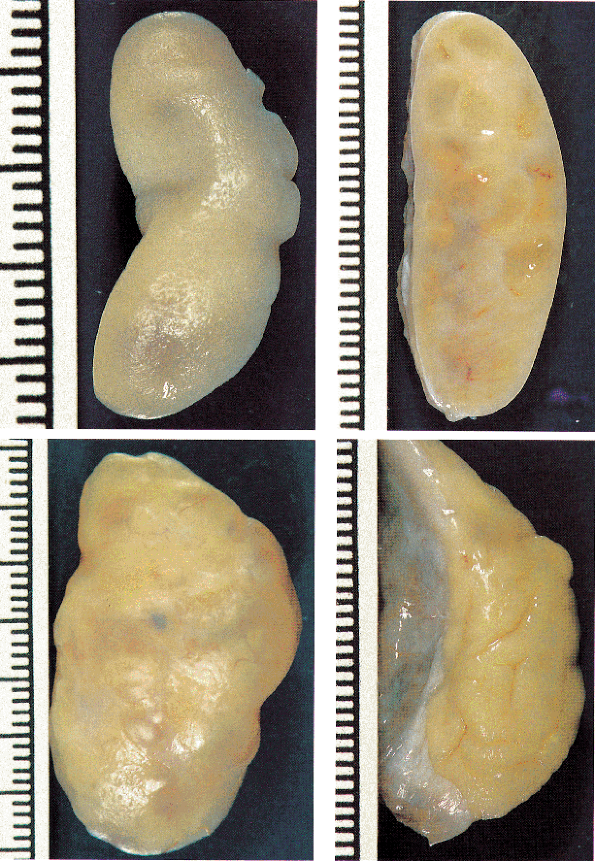 |
Figure 42.1 Gross appearance of ovary. A. Newborn, external aspect. B. Pubertal (age 15 years), sectioned surface. Note elongate shape and multiple cystic follicles. C. Adult (age 30), external aspect. D. Postmenopausal, external aspect. Note shrunken, gyriform appearance. |
In postmenopausal women, the medullary blood vessels may appear particularly numerous and closely packed (Figure 42.2) and should not be mistaken for a hemangioma on microscopic examination. In addition, many of the same vessels may be calcified or have thickened walls and narrowed lumina due to medial deposition of a hyaline, amyloid-like material.
Lymphatics
The lymphatics of the ovary originate predominantly within the theca layers of the follicles. The granulosa layer of a maturing follicle is devoid of lymphatics in contrast to its counterpart within the corpus luteum, which possesses a rich supply of lymphatics (24). The lymphatics pass through the ovarian stroma, independent of blood vessels, to drain into larger trunks that form a plexus at the hilus. Within the hilus, the lymphatics and blood vessels converge, with the former coiled around veins in a helicoid fashion. Four to eight efferent channels pass into the mesovarium where they converge to form the subovarian plexus, which, in turn, is joined by branches from the uterine (fallopian) tube and uterine fundus (24). Leaving the plexus, the drainage trunks diminish in number and size, passing along the free border of the infundibulopelvic ligament enmeshed with the ovarian veins. From there they accompany the ovarian vessels, juxtaposed to the psoas muscle, and drain into the upper para-aortic lymph nodes at the level of the lower pole of the kidney (24,25). The major lymphatic drainage of the ovary is therefore in a cephalad direction toward the para-aortic nodes. Accessory channels, however,
P.1066
may bypass the subovarian plexus, passing through the broad ligament to the internal iliac, external iliac, and interaortic lymph nodes, or in some females, via the round ligament to the iliac and inguinal lymph nodes (24,25). When the pelvic and para-aortic lymph nodes are extensively replaced by tumor, retrograde lymphatic flow may represent a rare mechanism of tumor spread to the ovaries.
 |
Figure 42.2 Numerous crowded thick-walled blood vessels within ovarian medulla of postmenopausal woman. Some of the vessels have an eosinophilic amyloid-like material within their walls. |
Nerve Supply
The nerve supply of the ovary arises from a sympathetic plexus that is enmeshed with the ovarian vessels in the infundibulopelvic ligament (26). Nerve fibers, which are predominantly nonmyelinated, accompany the ovarian artery, entering the ovary at the hilus. Delicate terminal fibers, many surrounding small arteries and arterioles, penetrate the medulla and cortex to terminate as plexuses surrounding the follicles (26,27). Adrenergic nerve fibers and terminals are in close contact with smooth muscle cells in the cortical stroma and theca externa. The physiological significance of ovarian sympathetic innervation is not clear, although it has been suggested that it may play a role in follicular maturation, follicular rupture, or both (26,28,29). In addition, catecholamines can stimulate progesterone production by the ovarian follicles and androgen production by the ovarian stroma in vitro (30).
Surface Epithelium
Histology
The surface epithelium of the ovary consists of a single, focally pseudostratified layer of modified peritoneal cells. The cells vary from flat to cuboidal to columnar and several types may be seen in different areas of the same ovary (Figure 42.3). The surface cells are separated from the underlying stroma by a distinct basement membrane. This epithelium is extremely fragile and is almost always denuded in oophorectomy specimens because of undesirable rubbing of the surface by the surgeon and the pathologist, as well as lack of prompt fixation resulting in drying. Preserved epithelium is often confined to areas protected by surface adhesions or lining sulci.
Histochemical studies have demonstrated glycogen, as well as acid and neutral mucopolysaccharides, within surface epithelial cells (31,32). Seventeen-beta hydroxysteroid dehydrogenase activity, absent in extraovarian mesothelial cells, also has been demonstrated (31). The surface epithelial cells are immunoreactive for cytokeratin, Ber-EP4, Wilms' tumor gene (WT1), calretinin, desmoplakin, vimentin, transforming growth factor alpha, v/ 3 integrin (and its ligand vitronectin), - and -catenins, and receptors for estrogen, progesterone, follicle stimulating hormone, and epidermal growth factor (33,34,35,36,37,38,39,40,41,42,43,44,45,46).
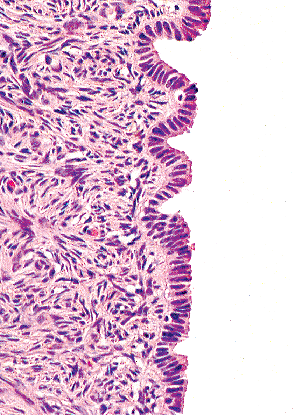 |
Figure 42.3 Ovarian surface epithelium composed of a single layer of columnar cells. |
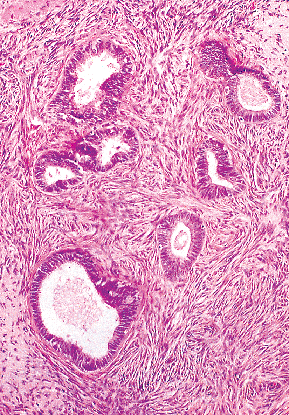 |
Figure 42.4 Epithelial inclusion glands within ovarian cortex. |
P.1067
Epithelial inclusion glands (EIGs) arise from cortical invaginations of the surface epithelium that have lost their connection with the surface. They often become cystic, resulting in epithelial inclusion cysts (EICs), which may be recognized on macroscopic examination; a diameter of 1 cm has been suggested as a dividing line between an EIC and the smallest cystadenoma. EIGs have been identified on microscopic examination of ovaries from all age groups, including fetuses, infants, and adolescents (47,48). Inclusion glands and cysts (EIGCs) become more numerous with age, and are common incidental findings in late reproductive and postmenopausal age groups. They are typically multiple, scattered singly or in small clusters throughout the superficial cortex (Figure 42.4); less commonly, extension into the deeper cortical or medullary stroma may occur. EIGCs are typically lined by a single layer of ciliated tubal-type columnar cells; psammoma bodies within their lumina or the adjacent stroma are occasionally present. Similar glands, with or without associated psammoma bodies, encountered on the ovarian surface, within periovarian adhesions, and on the extraovarian peritoneum and omentum, are designated endosalpingiosis (49). Less frequently, EIGCs may be lined by other m llerian epithelia (endometrioid, mucinous), or nonspecific columnar or flattened cells (50,51). EIGCs are probably the site of origin of most cystic surface epithelial tumors (52). One study (53) found that EIGCs were more common in ovaries contralateral to a unilateral ovarian carcinoma and that they more often were lined by serous epithelium than in age-matched control patients without ovarian carcinoma. Dysplastic changes also have been described within EIGCs (52,54).
The histogenetic relationship between the ovarian surface epithelium, EIGCs, and tumors of epithelial type is reflected by the presence of markers associated with ovarian epithelial tumors within the normal surface epithelial cells and/or the cells lining EIGs. These have included WT1, E-cadherin, p53, CA 125, CA 19-9, CEA, hCG, MH99, placental lactogen, alpha-2 glycoprotein, beta-1 glycoprotein, placental alkaline phosphatase, human milk fat globule protein, and v/ 3 integrin/vitronectin (55,56,57,58,59,60,61,62,63). Hyperplasia and metaplasia of the surface epithelium, and of that within EIGs, are more common in women with polycystic ovarian disease and endometrial carcinoma (64), suggesting a possible hormonal basis in some cases.
Urothelial differentiation is also within the metaplastic potential of the ovarian surface epithelium and pelvic peritoneum. Such differentiation typically takes the form of Walthard nests of transitional cells, a common microscopic finding within the serosa or the immediately subjacent stroma of the uterine (fallopian) tube, mesosalpinx, and mesovarium, or less commonly, the ovarian hilus (Figure 42.5) (65,66,67,68). The larger nests frequently become cystic and may be lined by columnar mucinous cells. Brenner tumors are also characterized by urothelial differentiation;
P.1068
as many as one-half of those encountered by the pathologist are of microscopic size.
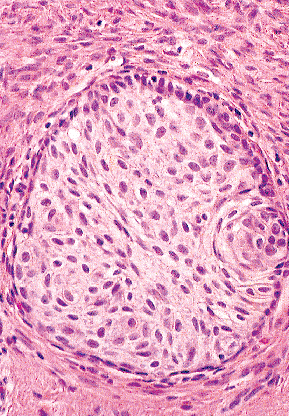 |
Figure 42.5 Walthard nest within ovarian hilus abutting medullary stroma. |
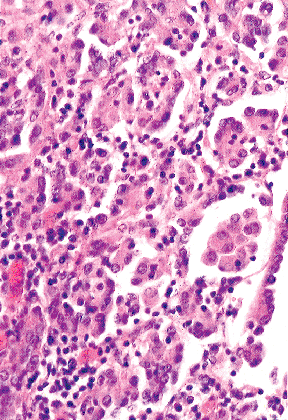 |
Figure 42.6 Hyperplastic mesothelial cells on ovarian surface. Note admixed inflammatory cells. |
Hyperplastic mesothelial cells, usually a response to chronic pelvic inflammation, may involve the surface of the ovary and focally replace the ovarian surface epithelium. Florid examples exhibiting tubulopapillary (Figure 42.6) and pseudoinfiltrative patterns, as well as varying degrees of nuclear atypia, must be distinguished from a malignant mesothelioma or a primary ovarian or metastatic carcinoma.
Ultrastructure
The ultrastructural appearance of the ovarian surface epithelium is similar to that of the extraovarian peritoneum (69,70,71). The cell surfaces by scanning and transmission electron microscopy have dome-shaped apices covered by numerous, often branching, microvilli, occasional single cilia, and pinocytotic vesicles (Figure 42.7). The cytoplasm contains abundant polysomes, free ribosomes, abundant mitochondria, and bundles of intermediate filaments and tonofilaments. Lipid droplets are sometimes present in the basal cytoplasm. The nuclei have indented nuclear membranes and peripheral nucleoli. Straight or convoluted lateral plasma membranes are reinforced by luminal junctional complexes, scattered desmosomes, and desmosomal-tonofilament complexes. The membranes may be widely separated in areas creating dilated intercellular spaces (70). A well-developed basal lamina separates the surface epithelium from the underlying stroma.
 |
Figure 42.7 Electron micrograph of ovarian surface epithelium. The cells have numerous microvilli (Mv) and well-developed organelles in a perinuclear location. The nuclei have indented membranes and peripheral nucleoli. The lateral plasma membranes are reinforced by luminal junctional complexes and scattered desmosomes, but are occasionally widely separated producing dilated intercellular spaces. A well-defined basal lamina (BL) separates the cells from the underlying stroma (original magnification x6400). Inset: the surface microvilli are associated with micropinocytotic vesicles (short arrows) and occasional single cilia (long arrows). Note Golgi complex (G) (original magnification x22,000). Reprinted with permission from: Ferenczy A, Richart RM. Female Reproductive System: Dynamics of Scan and Transmission Electron Microscopy. New York: John Wiley & Sons; 1974. |
P.1069
Stroma
Histology
As the cortical and medullary stroma is continuous and similar in appearance, the boundary between these two zones is ill defined and arbitrary. The spindle-shaped stromal cells, which have scanty cytoplasm, are typically arranged in whorls or a storiform pattern (Figure 42.8). Fine cytoplasmic lipid droplets may be appreciable with special stains, especially in the late reproductive and postmenopausal age groups (72). Immunohistochemical stains reveal cytoplasmic vimentin, actin, and desmin (33,35,36,73,74). Stromal cells are separated by a dense reticulum network (Figure 42.8 inset) and a variable amount of collagen that is most abundant in the superficial cortex. Although the latter is frequently referred to as the tunica albuginea, it lacks the densely collagenous, almost acellular appearance and sharp delineation of the tunica albuginea of the testis.
A variety of other cells may be found within the ovarian stroma, most of which are probably derived from the cells of fibroblastic type. Luteinized stromal cells, which lie in the stroma at a distance from the follicles, are found singly or in small nests, most often in the medulla. They are polygonal cells with abundant eosinophilic to clear cytoplasm containing variable amounts of lipid, a central round nucleus, and a prominent nucleolus (Figure 42.9). These cells are typically immunoreactive for inhibin (75,76,77,78,79), calretinin (46,80), melan-A (81), CD10 (82), and occasionally, testosterone (83). The numbers of luteinized stromal cells increase during pregnancy and after the menopause; they are probably secondary to elevated levels of circulating gonadotropins during these periods (22,72). In one autopsy study, luteinized stromal cells were demonstrated after diligent searching in 13% of women under the age of 55 and in one-third of women over that age; the frequency of their detection increased with increasing degrees of stromal proliferation (22). More exhaustive sampling might indicate that luteinized stromal cells are a normal finding in the ovary, particularly in later life. In this age group, the presence of luteinized cells is not usually associated with clinical evidence of a hormonal disturbance. In some older women, but more often in younger patients, however, more striking degrees of stromal luteinization (stromal hyperthecosis) are frequently associated with androgenic and estrogenic manifestations. Occasionally in such cases, nodules of luteinized stromal cells may be appreciable on low-power microscopic examination (nodular hyperthecosis).
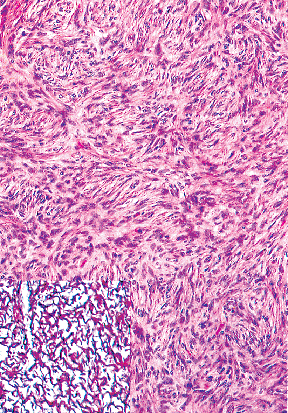 |
Figure 42.8 Ovarian stroma composed of whorls of plump spindle cells of fibroblastic type. Inset: note dense reticulum network (reticulin stain). |
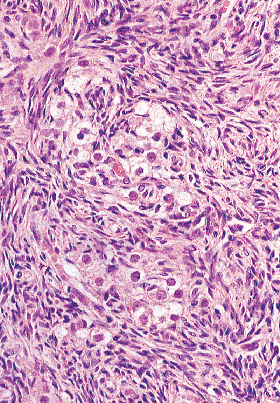 |
Figure 42.9 Luteinized stromal cells. |
Enzymatically active stromal cells (EASC) are characterized by their oxidative and other enzymatic activity (72,84,85,86). The frequency of their detection and their numbers increase with age, occurring in over 80% of postmenopausal women, typically in the medulla (84,85). Some EASC correspond to luteinized stromal cells, but most cannot be distinguished from neighboring, nonreactive stromal cells in routine histologic preparations (84).
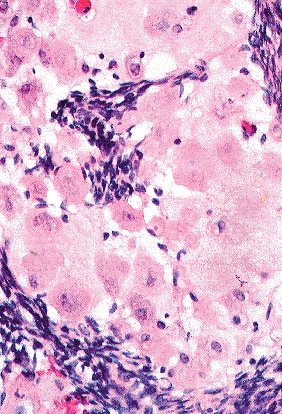 |
Figure 42.10 A nest of decidual cells within the ovarian stroma. |
P.1070
Decidual cells may occur singly, as small nodules, or as confluent sheets within the stroma of the superficial cortex or within periovarian adhesions (Figure 42.10). The appearance of the decidual cells is usually identical to eutopic decidua, but occasional examples may exhibit cytological atypia potentially mimicking metastatic carcinoma on histological examination (87,88,89,90,91,92). A network of capillaries and a sprinkling of lymphocytes are typically present within the decidual foci. A decidual reaction within the ovary is almost always a response of the ovarian stromal cells to elevated circulating or local levels of progesterone; progesterone receptors have been identified in the ovarian stromal cells (37). The process is seen most commonly in pregnancy, occurring as early as the ninth week of gestation, and by term is present in virtually all ovaries. Less commonly it may occur in association with trophoblastic disease, in patients treated with progestins, in the vicinity of a corpus luteum, or in association with hormonally active, hyperplastic or neoplastic ovarian lesions (22,87,89). Prior pelvic irradiation may be a predisposing factor by increasing the sensitivity of the stromal cells to hormonal stimulation (89). Foci of ovarian decidua have been occasionally described in both pre- and postmenopausal women with no obvious cause (22,89).
Foci of smooth muscle may be seen within the ovarian stroma (Figure 42.11), most commonly within perimenopausal or postmenopausal women (93). The smooth muscle is bilateral in about 25% of cases and usually is confined to a few microscopic fields. It is often associated with other findings in the ovary, occurring with the hyperplastic ovarian stroma associated with stromal hyperthecosis or sclerocystic ovaries (94), and within the stroma surrounding nonneoplastic and neoplastic cysts, including endometriotic cysts. Rare endometriotic cysts may contain prominent amounts of smooth muscle ( endomyometriosis ) (95). One study (93) found that almost 90% of women with ovarian smooth muscle metaplasia had uterine leiomyomas.
Nests of cells resembling endometrial stromal cells ( stromal endometriosis ) occur within the ovarian stroma, usually in the absence of typical endometriosis (Figure 42.12) (96,97). Foci of mature fat cells may be encountered as an incidental histological finding within the subcapsular ovarian stroma (98,99); a possible association with obesity was noted in one study (99). Reinke-crystal-containing Leydig cells, presumably representing transformed stromal cells, may occur rarely, and are typically associated with stromal hyperthecosis or within the nonneoplastic stroma in or adjacent to an ovarian neoplasm (100,101,102). So-called neuroendocrine or APUD type cells have been demonstrated within the ovarian stroma in approximately 6% of normal women in one study (103). The cells occur in small groups in the corticomedullary stromal junction and are argyrophilic and argentaffinic. Their clinical significance and hormonal function, if any, is unknown, but it has been suggested that they may represent the cell of origin of rare primary ovarian carcinoid tumors not associated with teratomatous or mucinous elements.
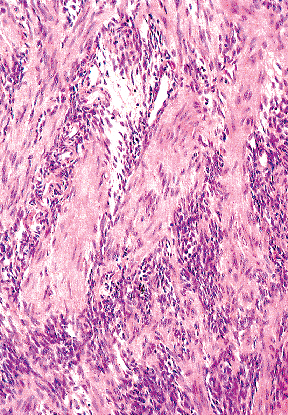 |
Figure 42.11 Smooth muscle cells within ovarian stroma. |
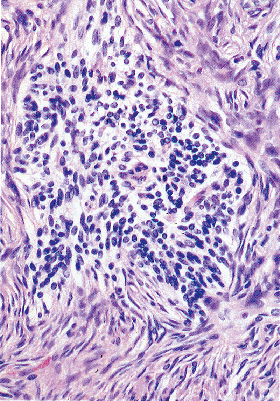 |
Figure 42.12 Focus of endometrial stromal cells ( stromal endometriosis ) within ovarian cortex. |
P.1071
Aging Changes
Although there is typically a gradual increase in its volume from the fourth to the seventh decades (21,104), the ovarian stroma in postmenopausal women exhibits a wide spectrum of appearances (22,70,88). At one extreme, there is stromal atrophy manifested by a thin cortex and minimal amounts of medullary stroma (Figure 42.13). At the other extreme, there is marked stromal proliferation warranting the designation stromal hyperplasia . Most postmenopausal subjects, however, exhibit varying degrees of nodular or diffuse proliferation of the cortical and medullary stromal cells that lie between these two extremes (Figure 42.14) (22,85), making the normal appearance difficult to define. Broad irregular areas of cortical fibrosis may be encountered in peri- and postmenopausal ovaries (22). When well-circumscribed, these foci resemble a small fibroma, but this designation is applied to lesions 1 cm or greater in diameter. A similar size limit could be used to distinguish between the foci of surface stromal papillarity commonly encountered in this age group (Figure 42.15) and serous surface papillomas. Cortical granulomas are common incidental microscopic findings in the late reproductive and postmenopausal age groups, having been demonstrated in up to 45% of women over the age of 40 (22,96,97,105,106,107). They consist of spherical circumscribed aggregates of epithelioid cells, lymphocytes, and
P.1072
occasionally, multinucleated giant cells and anisotropic fat crystals (Figure 42.16). Cortical granulomas and the spherical, cloud-like, hyalin scars (Figure 42.17) present within the superficial cortical stroma of almost all postmenopausal ovaries are of uncertain histogenesis. It has been suggested that they may represent regressed foci of stromal endometriosis, ectopic decidua, or luteinized stromal cells.
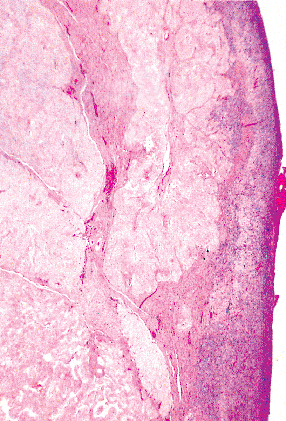 |
Figure 42.13 Atrophic postmenopausal ovary. The cortex is thin and multiple corpora albicantia are present within the medullla. |
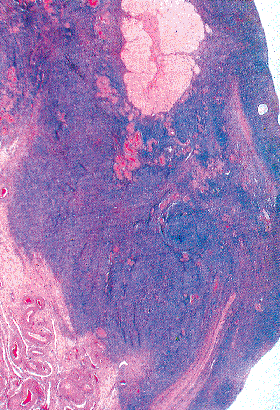 |
Figure 42.14 Postmenopausal ovary with a moderate degree of stromal proliferation. |
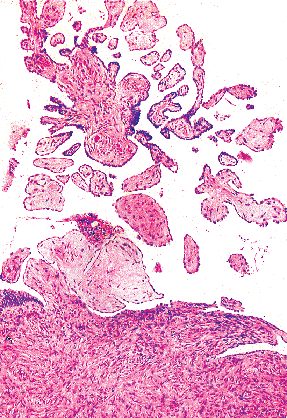 |
Figure 42.15 Papillary stromal projections from ovarian surface. |
Ultrastructure
Typical ovarian stromal cells have slender spindle-shaped nuclei and complex cytoplasmic processes (70,85). Their scant cytoplasm is rich in organelles required for collagen synthesis, including free ribosomes and mitochondria. Tropocollagen, concentrated at the periphery of the cytoplasm, is deposited in the extracellular space and eventually converted to collagen (Figure 42.18). Rows of micropinocytotic vesicles occur along the plasma membrane and desmosome-like attachments may be found between the cells (85). Luteinized stromal cells have abundant cytoplasm-containing lipid droplets and steroidogenic organelles, including smooth endoplasmic reticulum, mitochondria with tubular cristae, and Golgi (70,85,86,108). Some cells have ultrastructural features that are intermediate between those of fibroblasts and luteinized cells (70,85). Argyrophilic stromal cells have 300 to 750 nm, electron-dense, membrane-bound, cytoplasmic granules (103).
 |
Figure 42.16 Cortical granuloma. |
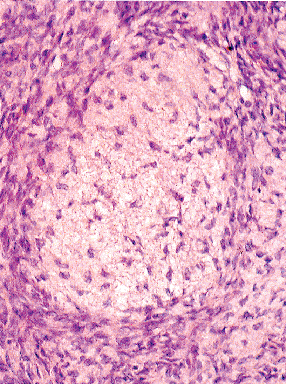 |
Figure 42.17 Hyalin scar. |
 |
Figure 42.18 Electron micrograph of ovarian stromal cells. The cells are fibroblastic in type. C: collagen fibers; Mf: tropocollagen; R: free ribosomes; Li: lipid inclusions; upper arrow, perinuclear clustering of mitochondria (original magnification x3000). |
P.1073
Hormonal Aspects
Numerous studies have demonstrated the steroidogenic potential and the gonadotropin-responsiveness of the ovarian stroma in both pre- and postmenopausal women (109,110,111,112,113,114,115,116,117,118,119,120,121). In vitro incubation of ovarian stromal tissue indicates that its principal steroid product is androstenedione, in addition to smaller quantities of testosterone and dehydroepiandrosterone (122). In vitro production of androgens is enhanced by human chorionic gonadotropin (hCG), pituitary gonadotropins, and insulin, consistent with the presence of receptors for these hormones within the stromal cells (83,86,123). To what extent the ovarian stroma contributes to the androgen pool in normal premenopausal women is unknown, but it is likely that it is the source of small amounts of testosterone. With cessation of follicular activity at the time of the menopause, the ovarian stroma becomes, together with the adrenal glands, the major source of androgens. Testosterone and androstenedione are the major androgens secreted by the ovarian stroma in postmenopausal women (109,110,111,113,121), and in vitro and in vivo studies have shown that ovaries with stromal hyperplasia secrete more androstenedione, estrone, and estradiol than normal ovaries (114,116). Approximately 80% of the circulating androstenedione in postmenopausal women, however, is of adrenal origin (110). Despite a cessation of follicular synthesis of estradiol (E2) in postmenopausal subjects, small amounts of this hormone are present in the circulation (probably derived from the adrenal glands) by peripheral conversion of estrone (110,124), and from the ovarian stroma itself (109,111,125). Estrone, however, becomes the major circulating estrogen after the menopause, derived predominantly from the peripheral aromatization of androstenedione that occurs in fat, muscle, liver, kidney, brain, and adrenals (110,125,126). Increased aromatization in postmenopausal women, likely due to high endogenous LH levels in these subjects, leads to a two-fold increase in the daily production rate of estrone compared to that in premenopausal women; aromatization is also higher in obese subjects. In some postmenopausal women, sufficient estrogen is elaborated by this mechanism to prevent the clinical manifestations of estrogen withdrawal and to play a role in the genesis of endometrial carcinoma (104,110). An association between the degree of stromal proliferation and postmenopausal endometrial adenocarcinoma has been noted (104), and the ovarian stroma in postmenopausal women with endometrial adenocarcinoma produces more androgens in vitro than that of control subjects without endometrial cancer (127). The variations that exist in the ovarian steroid hormone output from one postmenopausal woman to another may correspond to similar variations in the morphologic appearance of the stroma in this age group, although no correlative functional and structural studies have been performed.
P.1074
Primordial Follicles
Histology
The approximately 400,000 primordial follicles present at the time of birth fill the ovarian cortex (Figure 42.19). After this period, their numbers decrease progressively through the processes of atresia and folliculogenesis until their eventual disappearance that marks the end of the menopause. However, rare follicles may persist for several years after the cessation of menses, accounting for sporadic ovulation and occasional episodes of postmenopausal bleeding (128). In the reproductive era, primordial follicles are found scattered irregularly in clusters throughout a narrow band in the superficial cortex. They consist of a primary oocyte, measuring 40 to 70 m in diameter, surrounded by a single layer of flattened, mitotically inactive, granulosa cells resting on a thin basal lamina (Figure 42.20). Rare primordial (and maturing) follicles may contain multiple oocytes, particularly in individuals who are less than 20 years of age (19,129,130,131). The oocyte is arrested at the dictyate stage of meiotic prophase at the time of birth, enters an interphase period until follicular maturation prior to ovulation, or undergoes degeneration during atresia (132). The large spherical nucleus of the oocyte has finely granular, uniformly dispersed chromatin and one or more dense, thread-like nucleoli (132); rare oocytes may have multiple nuclei (130,131). The cytoplasm of the oocyte contains a paranuclear, eosinophilic, crescent-shaped zone consisting of a complex of interrelated organelles, so-called Balbiani's vitelline body (BVB) (133,134). Within the vitelline body is a dark spot (the centrosome) surrounded by a halo, which in turn is flanked by darker, PAS-positive, granular zones rich in mitochondria (133,14). The cytoplasm of the oocyte lacks the abundant glycogen and the high alkaline phosphatase activity characteristic of the primordial germ cells and the oogonia of the embryonic gonad.
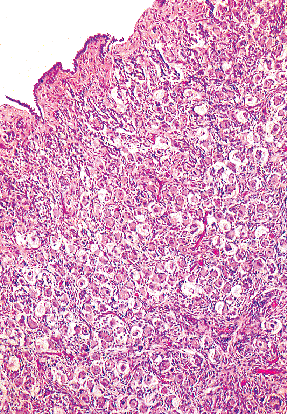 |
Figure 42.19 Newborn ovary. Multiple primordial follicles fill the ovarian cortex. |
 |
Figure 42.20 Primordial follicles (four at top of figure) and primary follicles (three at bottom of figure). |
Ultrastructure
The granulosa cells of the primordial follicle have sparse organelles, occasional desmosomal attachments with each other, and microvillous projections that attach to the oocyte by tight apposition (70). Within the oocyte, the juxtanuclear centrosome of the BVB (Figure 42.21A) consists of dense granules, closely packed vesicles, and dense fibers that form a basket-like structure at the periphery of the centrosome (Figure 42.21B) (133,134). The centrosome is surrounded by a zone of smooth endoplasmic reticulum (ER) that represents the halo seen by light microscopy. More peripheral and constituting the rest of the BVB are a concentration of most of the oocyte's organelles, including multiple Golgi complexes, prominent compound aggregates,
P.1075
numerous mitochondria intimately associated with sparsely granular ER, and annulate lamellae (Figure 42.21B) (133,134). The latter structures, which may be attached or immediately adjacent to the nucleus or free within the BVB, are constantly present in primary oocytes and other rapidly growing embryonal or neoplastic cells. They are arranged in stacks or concentric arrangements of up to 100 parallel, smooth, paired membranes that delineate greatly flattened cisternal spaces, 30 to 50 m wide. At regularly spaced intervals, the paired membranes of each lamellar unit become fused with one another (132). When the lamellae are sectioned along a tangential plane, the sites of apposition of the membranes are seen as regularly spaced annuli 100 nm in diameter. At their periphery they are connected to the granular ER (133). The paired membranes of the annulate lamellae mimic the two leaflets of the nuclear membrane, and it is likely that they are formed from its outer leaflet (70,132,133). Their function is not known with certainty, but it has been suggested that they may have a role in nucleocytoplasmic exchange of substances related to metabolic activity or the transfer of genetic information (70,133).
 |
Figure 42.21 Electron micrograph of a primordial follicle. A. Balbiani's vitelline body consists of a juxtanuclear centrosome (CS) surrounded by a condensation of mitochondria, Golgi complexes, endoplasmic reticulum, and lysosomes (original magnification. x2400). B. Detailed view of Balbiani's vitelline body. A cluster of closely packed spiral fibrils (arrow) is attached to the nuclear envelope (NM). The centrosome (CS) is composed of dense granules, some arranged periodically on fine fibers, and small vesicles, with a peripheral zone of endoplasmic reticulum and dense fibers. Surrounding the centrosome are masses of mitochondria (Mi) and compound aggregates (CA). A stack of annulate lamellae (AL) is seen tangentially. Note the prominent endoplasmic reticulum in close association with multiple Golgi complexes at the periphery of the vitelline body. Reprinted with permission from: Hertig AT. The primary human oocyte: some observations on the fine structure of Balbiani's vitelline body and the origin of the annulate lamellae. Am J Anat 1968;122:107 137. |
In some oocytes, Golgi, ER, and mitochondria may also be found outside the vitelline body, closely applied to the entire circumference of the nucleus (133). Similarly, microtubules present throughout the oocyte cytoplasm are most prevalent around the circumference of the nuclear membrane. Bundles of spiral filaments occasionally abut the nuclear membrane (Figure 42.21B) or are seen in the more peripheral cytoplasm (134). A variety of different vacuoles may also be seen in the peripheral cytoplasm, some containing multiple small vesicles (133).
Maturing Follicles
Histology and Ultrastructure
Folliculogenesis
Folliculogenesis refers to the continuous process occurring throughout reproductive life whereby cohorts of primordial follicles undergo maturation during each menstrual cycle. Follicular maturation begins during the luteal phase and continues throughout the follicular phase of the next cycle. Each month only one such follicle, the preovulatory (or dominant) follicle, achieves complete maturation, culminating in the release of the oocyte (ovulation). The other follicles that have begun the maturational process undergo atresia at earlier stages of their development. Folliculogenesis and atresia also occur prenatally, throughout childhood and during pregnancy, although maturing follicles rarely reach the preovulatory follicle stage during these periods (19,135,136,137,138,139,140,141,142,143).
P.1076
 |
Figure 42.22 Preantral follicle. Several layers of granulosa cells surround the oocyte. A theca interna layer is not yet apparent. |
The first morphological evidence of follicular maturation is the assumption of a cuboidal to columnar shape of the granulosa cells accompanied by enlargement of the oocyte (primary follicle) (Figure 42.20). Mitotic activity in the granulosa cells results in their stratification and three to five concentric layers around the oocyte (secondary or preantral follicle) (Figure 42.22). At this stage an eosinophilic, PAS-positive, homogeneous, acellular layer, known as the zona pellucida, appears, encasing the oocyte. Its formation is usually attributed to the granulosa cells, but the oocyte may also play a role. At the end of its development, the zona pellucida is a 20 to 25 m thick membrane rich in acid mucopolysaccharides and glycoprotein (Figures 42.22,42.23,42.24,42.25) (70). Preantral follicles measure from 50 to
P.1077
400 m in diameter, and as they increase in size, they migrate into the deeper cortex and medulla. Simultaneously, the surrounding ovarian stromal cells become specialized into several layers of theca interna cells and an outer, ill-defined layer of theca externa cells. Secretion of mucopolysaccharide-rich fluid by the granulosa cells results in their separation by fluid-filled clefts that eventually coalesce to form a single large cavity or antrum lined by several layers of granulosa cells (tertiary, antral, or vesicular follicle). The first evidence of antrum formation occurs in follicles that are 200 to 400 m in diameter, after which the follicles progressively enlarge due to continued fluid secretion into the antrum. Concurrently, the oocyte enlarges to its definitive size and assumes an eccentric position at one pole of the follicle. At this site the granulosa cells proliferate to form the cumulus oophorus which, containing the oocyte in its center, protrudes into the antrum (mature or Graafian follicle) (Figure 42.23).
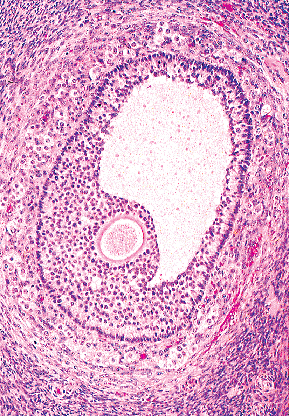 |
Figure 42.23 Mature follicle. Oocyte within cumulus oophorus projects into antrum. The theca layers are well developed. |
 |
Figure 42.24 A. Mature follicle, high power view. The granulosa layer, which contains several Call-Exner bodies, abuts the zona pellucida of the oocyte. The granulosa layer is surrounded by a layer of luteinized theca interna cells. Note mitotic figures in granulosa and theca cells. B. There is a reticulum network in the theca interna layer, but an absence of reticulin in the granulosa layer. |
Ovulation
During each cycle, only a small number of mature follicles (<4 per ovary) reach a diameter of 4 to 5 mm by the mid-to late luteal phase; one of them will become the preovulatory follicle of the subsequent cycle (144,145). Late in follicular growth, the oocyte, its surrounding zona pellucida, and a single layer of radially-disposed, columnar granulosa cells (the corona radiata) detach from the cumulus oophorus and float in the antral fluid. The preovulatory follicle, shortly before ovulation, reaches a diameter of 15 to 25 mm (28,145) and partially protrudes from the ovarian surface at the eventual rupture point, or stigma. Here the overlying surface epithelial cells exhibit progressive flattening, degeneration, and desquamation. The stroma in this area becomes attenuated and almost avascular, with degeneration of the stromal cells, fragmentation of collagen fibers, and an accumulation of intercellular fluid (28). These surface epithelial and stromal changes that immediately precede ovulation may be secondary to local ischemia and the release of proteolytic enzymes and prostaglandins into the stroma. The preovulatory follicle then ruptures, possibly secondary to the contraction of the perifollicular smooth muscle cells, with liberation of the follicular fluid and oocyte (with its surrounding layers) into the peritoneal cavity. Following ovulation, the stigma is occluded by a mass of coagulated follicular fluid, fibrin, blood, granulosa and connective tissue cells; it is eventually converted to scar tissue.
Shortly before ovulation, the oocyte within the ovulatory follicle enters telophase of the first meiotic division. Chromosomal reduction occurs by migration of one-half the oocyte chromosomes into a portion of the oocyte cytoplasm that separates from the cell as the first polar body. The first meiotic division begun in fetal life is now complete, and the oocyte is now designated the secondary oocyte. Immediately after expulsion of the first polar body, the secondary oocyte enters the second meiotic division, arresting at metaphase until fertilization occurs.
Granulosa Layer
Granulosa cells are almost entirely formed from their embryonic precursors by the time of birth (19). Those within maturing and mature follicles are polyhedral cells 5 to 7 m in diameter; the cells resting on the basement membrane are often columnar. The granulosa cells have pale, scanty cytoplasm, indistinct cell borders, and small, round to oval, hyperchromatic nuclei that typically lack nuclear grooves (Figure 42.24A) (146). Mitotic figures within granulosa cells are usually numerous in maturing follicles, decreasing in numbers prior to ovulation. Until the onset of luteinization several hours prior to ovulation, cytoplasmic lipid is absent (or sparse) as are steroidogenic histochemical patterns (147,148). The cytoplasm of granulosa cells of primary, secondary, and mature follicles is immunoreactive for cytokeratin, vimentin, inhibin, CD99, melan-A, m llerian inhibiting substance, WT1, and desmoplakin (33,35,36,75,77,78,81).
The granulosa cells typically surround small cavities, referred to as Call-Exner bodies (Figure 42.24A), which have a distinctive appearance, representing one of the most specific features of granulosa cells, both normal and neoplastic. Call-Exner bodies are delimited from the granulosa cells by a basal lamina, and typically contain a deeply eosinophilic, PAS-positive, filamentous material consisting of excess basal lamina (70). Unlike the theca layers, the granulosa layer of the maturing and Graafian follicles is avascular and devoid of a reticulum framework (Figure 42.24B).
Mitochondria with lamelliform cristae, granular ER, free ribosomes, and Golgi gradually increase in abundance within the granulosa cells of maturing follicles. These ultrastructural features suggest active protein synthesis. Histochemical and ultrastructural features (abundant smooth ER and mitochondria with tubular cristae) indicative of steroid biosynthesis are absent until shortly before ovulation (72,84,147,148,149,150). The granulosa cells of follicles of varying stages contain adhaerens junctions, gap junctions, and desmosomes between adjacent granulosa cells (35,70,132). The slender cytoplasmic extensions of the granulosa cells of the corona radiata that traverse the zona pellucida have gap junctions and puncta adhaerentia with the plasma membrane of the oocyte (Figure 42.25).
Theca Layers
In contrast to granulosa cells, theca cells differentiate continuously from the stromal cells at the periphery of developing follicles from fetal life until the end of the menopause. The thecal component of the antral follicle is
P.1078
characterized by a well-developed theca interna and a less well-defined theca externa. The theca interna layer is three or four cells in thickness and lies external to the granulosa layer (Figure 42.24A) from which it is separated by a basement membrane. Unlike the granulosa cells of the developing and mature follicles, the theca interna cells typically have a luteinized or partially luteinized appearance (Figure 42.24A) and exhibit steroidogenic histochemical patterns (72,147,148,149). Luteinization of the theca interna of maturing follicles is particularly prominent during pregnancy. The round to polygonal cells are 12 to 20 micra in diameter and have abundant, eosinophilic to clear, vacuolated cytoplasm containing variable amounts of lipid; a central, round, vesicular nucleus typically contains a single, prominent nucleolus (Figure 42.24A). The cells differ from granulosa cells but resemble stromal cells in being immunoreactive for vimentin but not cytokeratin (36); theca cells are also immunoreactive for inhibin, calretinin, and melan-A (46,77,81). Mitotic figures are typically present with the theca cells of maturing follicles. The layer contains a rich vascular plexus consisting of dilated capillaries, as well as a dense reticulin network that surrounds each cell (Figure 42.24B). A tangential section through the theca interna may result in seemingly isolated nodules of luteinized theca cells that may occasionally be misinterpreted as foci of stromal luteinization.
 |
Figure 42.25 Maturing oocyte. Note the uniform distribution of the organelles and the row of dense granules in the cytoplasm immediately subjacent to the plasma membrane of the oocyte. A continuous zona pellucida (zp) surrounds the oocyte and separates it from the granulosa cells. Numerous cytoplasmic processes of the granulosa cells are visible within the zona pellucida. N, nucleolus. Thick section, OsO4 fixed, Epon-embedded, toluidine blue stain. Reprinted with permission from: Baca M, Zamboni L. The fine structure of the human follicular oocytes. J Ultrastruct Res 1967;19:354 381. |
The theca externa is an ill-defined layer of variable thickness that surrounds the theca interna and merges almost imperceptibly with the adjacent ovarian stroma. It is composed of circumferentially arranged collagen bundles, blood and lymphatic vessels, and plump spindle cells that lack steroidogenic histochemical features (151). The spindle cells of the theca externa are typically highly mitotic and may be misinterpreted as fibrosarcoma, particularly when only the edge of the follicle is seen microscopically (Figure 42.26).
Ultrastructural examination of theca interna cells reveals the organelles associated with steroidogenesis, similar to those within granulosa-lutein cells. The theca externa cells,
P.1079
some of which exhibit smooth muscle differentiation, lack such organelles (152).
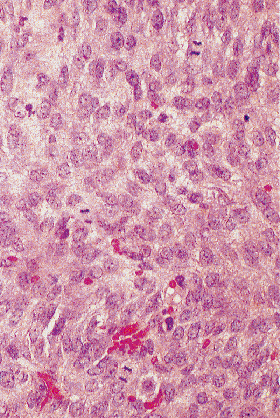 |
Figure 42.26 Theca externa of mature follicle composed of plump spindle cells. Note mitotic figures. |
Hormonal Aspects
The initiation of folliculogenesis and early preantral follicular development is independent of gonadotropin influence, whereas the later stages of follicular maturation are under gonadotropin control. As a small antral follicle develops into a preovulatory follicle, the sequence of endocrine events within its antral fluid differs from most, if not all, other antral follicles in the same ovary (153,154). The early stages of this development are associated with an increase in FSH receptors and intrafollicular FSH within the preovulatory follicle (153,154,155,156). There is a concomitant increase in estradiol (E2) receptors within the granulosa cells and the E2 level within the follicular fluid. The latter reaches peak concentration (10,000 times the circulating level) during the mid- to late proliferative phase when plasma FSH falls to a basal level. At this stage the preovulatory follicle is self-sustaining, continuing to mature under the influence of intrafollicular FSH and E2 (118). During the late proliferative phase, plasma LH rises and LH-receptors within the granulosa cells of the preovulatory follicle (but not other follicles) become apparent (156). In contrast, LH-receptors are present within the theca cells of all follicles throughout the follicular phase. Eden et al. found concentrations of insulin-like growth factor (IGF1) to be significantly higher in the follicular fluid of preovulatory follicles than their matched cohorts, and suggested that IGF1 may have a role in the selection of the dominant follicle (157).
Whereas circulating E2 is likely derived from both the granulosa cells and the LH-stimulated theca cells, intrafollicular E2 is derived almost exclusively from the granulosa cells by both de novo synthesis and by FSH-dependent aromatization of theca-derived androstenedione (118,158). Aromatase activity is highest in the preovulatory follicle, thereby maintaining a high E2:androstenedione ratio (153,154,159). In contrast, follicles that will undergo atresia are FSH- and aromatase-deficient and have high androstenedione:E2 ratios within their intrafollicular fluid. High circulating estrogen levels initiate a preovulatory surge of plasma LH (160,161) that induces luteinization of the granulosa cells, an increase in intrafollicular progesterone (P) concentration, and a small preovulatory rise in circulating P (153,154,162). The rising plasma P level and the peaking estrogen level further augment the LH surge, as well as initiating a smaller increase in FSH, triggering ovulation. The latter has been estimated to occur 36 to 38 hours after the onset of the LH surge, 24 to 36 hours after the estradiol peak, and 10 to 12 hours after the LH peak (162).
The ovarian follicles also produce nonsteroidal hormones. Inhibin, a glycoprotein synthesized by the granulosa cells, is secreted into the follicular fluid and ovarian venous effluent in amounts that correlate with steroid levels (162,163,164). Inhibin, which is predominantly under the control of LH (165), reduces, by negative feedback, FSH secretion from the hypothalamic pituitary unit. High concentrations of prorenin are present within the fluid of mature follicles (166), and their granulosa cells, as well as theca and stromal cells, are immunoreactive for renin and angiotensin II (167). The function, if any, of the renin angiotensin system within the ovary is currently unknown.
Corpus Luteum of Menstruation
Following ovulation on the fourteenth day of the typical 28-day menstrual cycle, and in the absence of fertilization, the collapsed ovulatory follicle becomes the corpus luteum of menstruation (CLM). When mature, the CLM is a 1.5 to 2.5 cm, round, yellow structure with festooned contours and a cystic center filled with a gray, focally hemorrhagic coagulum.
Histology
During the 14 days following ovulation, the CLM undergoes an orderly sequence of histological changes that allow an approximate estimation of its age. Corner has described these stages in detail, using endometrial histology and menstrual data to establish the age of the CLM (168,169). A subsequent study that correlated the histologic date of the CLM (using Corner's criteria) with the interval between the LH peak and the biopsy of the CLM, determined that the use of the histology of the CLM for retrospective timing of ovulation is subject to an error of variable magnitude due to unequal duration of each stage as well as considerable individual variation (170).
In contrast to the granulosa cells of the maturing and preovulatory follicles, the luteinized granulosa cells of the mature CLM (granulosa-lutein cells) are large, 30 to 35 micra, polygonal cells with abundant, pale, eosinophilic cytoplasm that may contain numerous small lipid droplets (Figures 42.27, 42.28) (151). The spherical nucleus contains one or two large nucleoli. The histochemical pattern of these cells varies with the age of the CLM, but is generally typical of steroid hormone-producing cells (72,148,149,171). The cytoplasm of luteinized granulosa cells contains vimentin, but in contrast to granulosa cells of maturing and mature follicles, little or no cytokeratin (35). The luteinized granulosa cells are also immunoreactive for inhibin and calretinin (46,77).
The theca interna forms an irregular and often interrupted layer several cells in thickness around the circumference of the CLM (Figure 42.27) and ensheathes the vascular septa that extend into its center (151). When these septa are cut in cross section, triangular-shaped nests of theca cells appear at intervals throughout the granulosa layer. In all but the earliest stages of the CLM, the theca lutein cells are approximately half the size of granulosa-lutein cells. They contain a round to oval nucleus with a
P.1080
single prominent nucleolus. Their less abundant, more darkly staining cytoplasm contains lipid droplets, which are usually larger than those in granulosa-lutein cells, and exhibits steroidogenic histochemical patterns (148), and immunoreactivity for inhibin, calretinin, and melan-A (46,77,81).
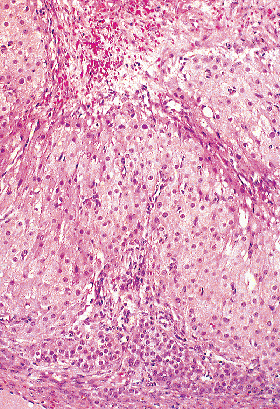 |
Figure 42.27 Mature corpus luteum of menstruation. The lining is composed of a thick layer of large granulosa-lutein cells and an outer, thinner layer of smaller theca-lutein cells. The cavity (top of figure) contains erythrocytes and fibrin. |
 |
Figure 42.28 Mature corpus luteum of menstruation. K cells with darkly staining cytoplasm and pyknotic nuclei are interspersed between granulosa-lutein cells. |
A third type of cell, the so-called K cell, occurs in small numbers within the theca interna of the mature follicle and appears in greater numbers within the granulosa layer of the early CLM (146). K cells persist until menstruation at which time they degenerate. They are characterized by a stellate shape, a deeply eosinophilic cytoplasm, and an irregular, hyperchromatic or pyknotic nucleus (Figure 42.28). The cytoplasm is uniformly sudanophilic due to the presence of phospholipid (146). K cells lack the histochemical patterns of steroidogenic cells and have been shown to be T-lymphocytes (172).
During the maturation of the CLM, capillaries originating from the theca interna layer penetrate the granulosa layer and reach the central cavity. Fibroblasts that accompany the vessels form an increasingly dense reticulum network within the granulosa layer as well as an inner fibrous layer that lines the central cavity (Figure 42.27) (32).
Involutional changes begin on the eighth or ninth day following ovulation (168). The granulosa-lutein cells decrease in size, develop pyknotic nuclei, and accumulate abundant cytoplasmic lipid (Figure 42.29). There is a
P.1081
decrease in histochemical staining of enzymes associated with steroid biosynthesis and an increase in hydrolytic enzymes (149). Eventually the cells undergo dissolution and are phagocytosed (173). There is progressive fibrosis and shrinkage over a period of several months and eventual conversion to a corpus albicans.
 |
Figure 42.29 Degenerating corpus luteum of menstruation. Granulosa-lutein cells have pyknotic nuclei and abundant cytoplasmic lipid. |
Ultrastructure
At the ultrastructural level, luteinization is characterized by a gradually increasing content of steroidogenic organelles, specifically smooth ER and abundant mitochondria with tubular cristae (Figure 42.30) (151,173,174,175,176). The smooth ER exhibits a characteristic regional modification in the form of a folded-membrane complex consisting of highly-folded, radiating, tubular cisternae that communicate and interdigitate with adjacent cisternae (175). Well-developed, dispersed and perinuclear Golgi, free and bound ribosomes, lipid droplets, and lipofuscin pigment are also seen (Figure 42.30) (151,173,174,175). The cells are separated by a narrow space of variable width, but occasionally the outer leaflets of their plasma membranes become closely apposed and reinforced by desmosomal and pentilaminar tight junctional complexes (151,173,176). Nearly all the cells have a free surface that borders on a broad pericapillary space from which they are separated by an interrupted basal lamina (151). Many irregular microvillous cytoplasmic extensions project into these pericapillary, as well as the intercellular, spaces (Figure 42.30) (70,151,173,175). Occasional interdigitation of these microvilli between adjacent cells form intercellular channels (175). Underlying the microvilli is a narrow zone of cytoplasm filled with a network of filaments that also extend into the microvilli (151).
Theca-lutein cells are similar ultrastructurally to granulosa lutein cells except for the presence of localized perinuclear Golgi and the absence of folded-membrane complexes, microvilli, and a network of fine filaments (151,175). The varying degrees of cell density appreciable on histological examination are also seen at the ultrastructural level and may represent a fixation artifact. The theca externa layer of the CLM does not differ significantly from that of the Graafian follicle.
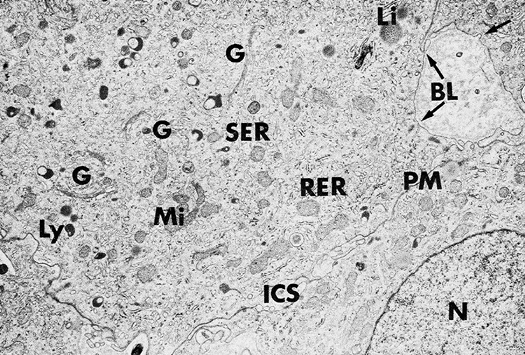 |
Figure 42.30 Electron micrograph of granulosa-lutein cell of a mature corpus luteum of menstruation. Note abundant smooth ER (SER), mitochondria (Mi), Golgi complex (G), rough ER (RER), lipid droplets (Li), and intercellular space (ICS). BL, basal lamina; N, nucleus of granulosa-lutein cell; Ly, lysosomes; PM, plasma membrane; arrows, micropinocytotic vesicle (original magnification x3600). Reprinted with permission from: Ferenczy A, Richart RM. Female Reproductive System: Dynamics of Scan and Transmission Electron Microscopy. New York: John Wiley & Sons; 1974. |
The lutein cells of the degenerating CLM exhibit disorganization and fragmentation of the smooth ER, alterations of the mitochondria, and an increase in cytolysosomes (70). Lipid droplets are increased and irregular in size and show increased osmiophilia (173).
Hormonal Aspects
The formation and function of the CLM is under the control of LH, reflected by the high content of LH receptors within the granulosa-lutein cells (156,162). Receptors for FSH (140) and growth hormone (158) have also been identified in the corpus luteum, although their roles in luteal function are unknown. Although P is the major steroid formed in vivo and in vitro by the CLM, it also synthesizes (both in vitro and in vivo) estrone and E2, as well as androgens, mostly androstenedione (177).
After ovulation, LH, FSH, and E2 levels fall, but the LH concentration is sufficient to maintain the CLM, producing a mid-luteal peak in P and E2. If fertilization does not occur, the increased levels of P and estrogen through negative feedback result in a fall of LH and FSH to basal levels, a reduction in LH and FSH receptors within the CLM, and a marked decline in P and E2 synthesis after the 22nd day of the cycle (155,156,162,178,179). These changes are reflected by the morphological involution of the CLM and the onset of menses. Luteolysis appears to be estrogen related, possibly secondary to an estrogen-induced reduction in LH receptors or by enhancement of the luteolytic action
P.1082
of prostaglandins synthesized by the CLM (162,180). A nonsteroidal LH-receptor-binding-inhibitor, which increases in concentration during the luteal phase, may also play a role (162).
Corpus Luteum of Pregnancy
Gross Appearance
On gross inspection, the corpus luteum of pregnancy (CLP) may be indistinguishable from the CLM, but is usually larger and bright yellow in contrast to the orange-yellow of the late CLM (181). The larger size, which may account for up to half the ovarian volume, is due primarily to the presence of a central cystic cavity that is filled with fluid or a coagulum composed of fibrin and blood (91,141,182). The cavity size, however, can be highly variable. If the central cyst results in a corpus luteum that is over 3 cm in diameter, the CLP (or less commonly a CLM) is designated a corpus luteum cyst; if less than this size, a cystic corpus luteum. When the cavity of a CLP is large, typically in the first trimester, the wall may lose its convolutions, becoming stretched and attenuated to the extent that it may consist focally of only the inner fibrous layer. Obliteration of the cavity usually begins by the fifth month and is typically completed by term (142). The CLP thus gradually decreases in size, and by the last trimester, it is not a conspicuous structure. During the puerperium, the CLP undergoes involution and conversion to a corpus albicans.
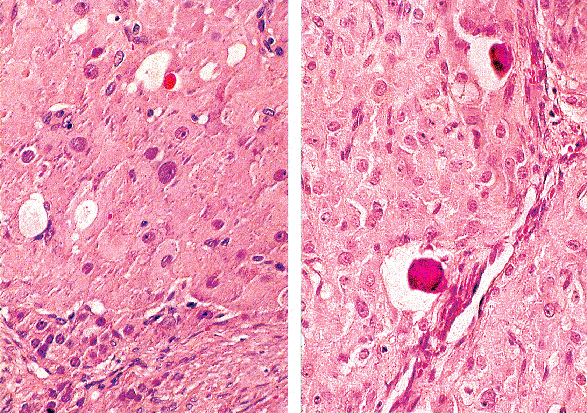 |
Figure 42.31 Corpus luteum of pregnancy. A. Note granulosa-lutein cells with large irregular vacuoles and densely eosinophilic hyalin body. Nests of theca cells are seen at bottom left. B. Focal calcification within a late corpus luteum of pregnancy. |
Histology
The CLP, in contrast to the CLM, does not mature in an orderly sequence that allows an estimation of its age; however, early and late stages are recognizable on histological examination.
Granulosa Layer
The first morphological evidence within the corpus luteum that conception has occurred is the absence of the regressive changes that normally appear in the CLM on the 8th or 9th days. Instead, the granulosa lutein cells enlarge, reaching their maximum size of 50 to 60 m by 8 to 9 weeks' gestation. They assume a round or polyhedral shape with abundant eosinophilic cytoplasm, round to oval, vesicular nuclei, and one or two prominent nucleoli (142) (Figure 42.31A). The granulosa cells of the early CLP are characterized by cytoplasmic vacuoles that initially are tiny but eventually enlarge to occupy almost the entire cell, often with displacement and flattening of the nucleus (Figure 42.31A). The vacuoles tend to diminish in number and size as gestation progresses, and usually disappear after the 4th month. Fine, diffusely scattered, cytoplasmic lipid droplets are also commonly seen within the cells, particularly in early CLP. With increasing age of the corpus luteum, the droplets become fewer and larger (142).
Eosinophilic colloid or hyalin droplets within the granulosa cells of a CLP, which can be identified as early as 15 days after ovulation, are almost diagnostic of pregnancy; they may occur very rarely, however, within a CLM (142). These inclusions initially appear as small, round or irregular,
P.1083
often multiple, droplets that enlarge, possibly by fusion of smaller droplets into one or several large bodies that may fill the entire cell (Figure 42.31A). They become more numerous as gestation progresses (182), although by term their numbers decrease as they undergo calcification, which continues into the puerperium (Figure 42.31B). It is likely that these calcified bodies eventually are resorbed, as they are not a feature of corpora albicantia.
K cells identical to those within CLM are typically found in the granulosa layer of the early CLP. They are most numerous in the second, third, and fourth months of gestation after which time they are rarely encountered (141,142,182).
Theca Layer
The theca interna is thickest in the early CLP at which time it resembles its counterpart in the CLM, surrounding the granulose-lutein layer and forming triangular-shaped, vascular septa that extend into the latter. In the CLP, the theca cells are polyhedral or round and approximately one fourth the size of the granulosa-lutein cells (Figure 42.31A). Their cytoplasm is more darkly staining and granular than in the latter, and is typically not vacuolated. Their nuclei are central, round, and more hyperchromatic than those of the granulosa cells; one or two prominent nucleoli are usually present. The characteristic colloid inclusions seen within the granulosa cells are absent or very rare within the theca cells. Occasional K cells may be seen in early pregnancy, but in smaller numbers than in the granulosa layer (146,182). After the 4th month, the theca interna and its trabeculae become much thinner as the theca cells become smaller and fewer in number, with darker, more irregular, oblong to spindle-shaped nuclei, so that they resemble fibroblasts (182). By term, the theca interna layer has almost completely disappeared.
Connective Tissue
As in the mature CLM, the central cystic cavity is typically lined by a layer of fibrous tissue, composed of variable numbers of fibroblasts, collagen and reticulin fibers, and blood vessels (126). Its thickness is highly variable, not only within the same CLP, but also from one CLP to another and from one phase of pregnancy to another (182). As noted, in some CLP with large cystic cavities, the granulosa layer is focally absent, and its wall is formed entirely by this fibrous layer. As gestation advances, the central cyst or coagulum is eventually obliterated by connective tissue that may exhibit focal hyalinization and calcification (141).
Reticulin staining reveals a pattern similar to that of the mature CLM; that is, a dense pattern within the theca interna and inner fibrous layer, and a sparser framework within the granulosa layer (142). In the early CLP, many, often large, vessels are present in the theca externa and interna, from which emanate smaller vessels that penetrate the granulosa and inner fibrous layers. In the late CLP, the vessels develop sclerotic walls with luminal narrowing or obliteration (142,182). The amount of connective tissue around the vessels increases in proportion to the decreasing vascularization and regression of the theca interna layer.
Ultrastructure
The ultrastructural appearance of the CLP is similar to that of the CLM, and remains intact throughout pregnancy despite a reduction in its metabolic activity (183,184,185). The increased cell volume of the granulosa cells in the CLP is reflected by increased smooth ER that exhibits many folded-membrane complexes. There is also an increase in rough ER that is localized in stacks and characteristic concentric whorls not usually seen in the CLM (175,184). Electron-dense, 150 to 200 nm, membrane-bound granules are closely associated with the cisternae of the rough ER. Mitochondria, including large spherical mitochondria not seen in the CLM, are typically highly variable in their size, shape, and internal structure (175,184). The colloid or hyalin inclusions consist of homogeneous electron-opaque material that may surround occasional needle-shaped crystals (Figure 42.32). They typically have no relationship to any organelle, although occasional smaller hyalin bodies are surrounded by rough ER. The vacuoles seen by light microscopy are lined by attenuated microvilli and contain an electron-translucent material (183). Unlike the CLM, extensive bundles of microfilaments are typically encountered throughout the cytoplasm in most lutein cells, and become more prominent as pregnancy progresses (183,184). Collagen fibrils are encountered more frequently in the intercellular and perivascular spaces of the term CLP compared to the CLM.
Hormonal Aspects
Following fertilization, placental hCG stimulates P production by the granulosa-lutein cells. P concentration within the postovulatory corpus luteum increases six-fold, while the E2 level drops to 10% of that within the preovulatory follicle (153,154). HCG alone cannot maintain P secretion from the CLP for more than a few days, and the regulation of P secretion beyond that time is unknown. P production by the CLP begins to decline by the end of the second month of gestation with a concomitant increase of placental P production. However, in vivo and in vitro studies indicate that the CLP continues to produce P throughout the remainder of gestation, albeit in reduced amounts, consistent with the maintenance of its structural integrity until term (140,183,184,186,187). It is not known if P derived from the CLP has a biological role during this period or is redundant because of the massive P production by the placenta (177,188).
P.1084
There is a rapid decline in function during the puerperium, reflecting falling hCG levels during this period.
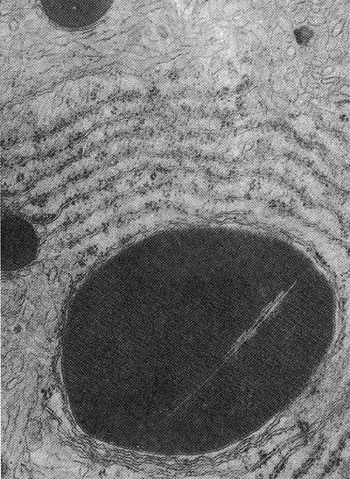 |
Figure 42.32 Hyalin bodies within a lutein cell from a corpus luteum of pregnancy consisting of homogeneous, electron-opaque material. Note needle-shaped cleft within the largest hyalin body. Some smaller hyalin bodies are surrounded by granular ER (original magnification x22,000). Reprinted with permission from: Adams EC, Hertig AT. Studies on the human corpus luteum. I. Observations on the ultrastructure of development and regression of the luteal cells during the menstrual cycle. J Cell Biol 1969;41:696 715. |
Relaxin, a polypeptide hormone, is also produced during gestation and the puerperium by the CLP, probably under the control of hCG (188,189,190,191). The concentration of relaxin in ovarian vein plasma during pregnancy correlates with P levels. The placenta and uterus have also been suggested as additional, but less important, sources for this hormone. Its reported actions include cervical dilatation and softening, inhibition of uterine contractions, and relaxation of the pubic symphysis and other pelvic joints (188,189,190,191). Immunoreactivity for renin and angiotensin II, similar to that noted within the preovulatory follicle (see above), has been demonstrated within the CLP (167), consistent with the observation that prorenin, likely of ovarian origin, increases 10-fold in pregnant women soon after conception (166).
Corpus Albicans
The regressing CLM is invaded by connective tissue that gradually converts it to a scar, the corpus albicans. The degenerating corpus luteum and the young corpus albicans may contain macrophages laden with ceroid and hemosiderin pigment (192,193). The mature corpus albicans is a well-circumscribed structure with convoluted borders composed almost entirely of densely packed collagen fibers with occasional admixed fibroblasts (Figures 42.13, 42.33). Focal calcification and ossification may be occasionally encountered. Most corpora albicantia are eventually resorbed and replaced by ovarian stroma. Persistent corpora albicantia are typically found in the medulla of postmenopausal women (Figure 42.13) suggesting that this resorption process decelerates or terminates prior to the menopause.
Atretic Follicles
Histology
Of the original 400,000 primordial follicles present at birth, approximately 400 mature to ovulation. The remaining 99.9% undergo atresia, a process that begins before birth and continues throughout reproductive life, but is most intense immediately after birth and during puberty and pregnancy (135,136,137,138,139,141,143). Factors that initiate atresia and determine which follicles will ultimately undergo atresia are unknown. The atretic process varies with the stage of follicular maturation that has been reached. Atresia of early follicles (primordial and preantral) begins with degeneration
P.1085
of the oocyte manifested by nuclear changes (chromatin condensation, pyknosis, fragmentation) and cytoplasmic vacuolation. Degeneration of the granulosa cells soon follows and the follicle disappears without a trace. In contrast, atresia of follicles that have reached the antral stage of development is more complex and variable, but ultimately leads to obliterative atresia and the formation of a scar, the corpus fibrosum. The earliest evidence of this process is mitotic inactivity of the granulosa cells and a decrease in their numbers, manifested by thinning and focal exfoliation of the granulosa layer. Some follicles may persist for an indefinite period of time at this stage as atretic cystic follicles (Figure 42.34); those that exceed 3 cm are designated follicular cysts. Atretic cystic follicles and follicular cysts may persist for a number of years after the menopause (194,195). Atretic follicles are ultimately invaded by vascular connective tissue that eventually fills the central cavity (Figure 42.35). The oocyte may persist for an indefinite period of time but eventually degenerates. Concurrent with these changes, the basement membrane between the granulosa and theca interna layers becomes transformed into a thick, wavy, eosinophilic, hyalinized band, the so-called glassy membrane (Figures 42.35, 42.36). The theca interna layer typically persists, often with prominent luteinization (Figures 42.35, 42.36), until the late stages of
P.1086
atresia at which time cords and nests of theca cells become surrounded by proliferating connective tissue (Figure 42.36). Luteinization of both theca and granulosa layers is particularly striking in atretic follicles during infancy and childhood (196) and pregnancy (Figure 42.37) (142).
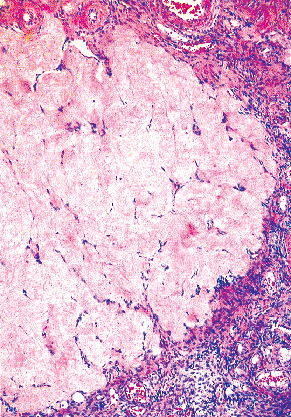 |
Figure 42.33 Corpus albicans. |
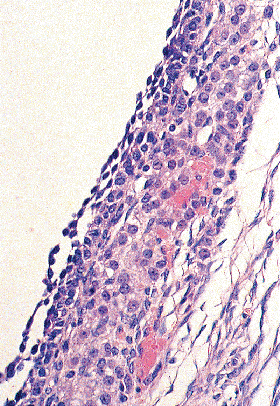 |
Figure 42.34 Lining of atretic cystic follicle composed of a thin inner layer of small, exfoliating granulosa cells and an outer, luteinized theca interna layer. |
 |
Figure 42.35 Atretic cystic follicle undergoing obliterative atresia. Loose connective tissue is replacing the central cavity. The wavy basement membrane ( glassy membrane ) is thickened and hyalinized. A prominent layer of luteinized theca interna is evident. |
 |
Figure 42.36 Edge of follicle in late stage of obliterative atresia. Hyalinized fibrous tissue occupies the central cavity and extends into the persistent luteinized theca interna layer. |
Microscopic proliferations of persistent granulosa cells within the centers of atretic follicles of pregnant, and less commonly nonpregnant women, may mimic small granulosa cell tumors (Figure 42.37), or rarely, Sertoli cell tumors (197). Similarly, structures resembling microscopic gonadoblastomas and sex cord tumors with annular tubules have been identified within atretic follicles in up to 35% of normal fetuses and infants (131,198,199). There is no evidence to suggest that any of these tumorlike proliferations represent early stages of neoplasia.
Continued shrinkage and hyalinization of an atretic follicle produces a serpiginous strand of hyalin tissue, the corpus fibrosum or atreticum (Figure 42.38). Like corpora albicantia, most corpora fibrosa are probably resorbed by the ovarian stroma.
Hormonal Aspects
In contrast to preovulatory follicles, the microenvironment of follicles undergoing atresia is predominantly androgenic, with high concentrations of intrafollicular androstenedione and low concentrations of FSH and E2 (17,119,153,154,200). As noted, these follicles are deficient in granulosa cells, and the residual granulosa cells do not respond to FSH in vitro (145); both FSH- and LH-receptors are lower than in nonatretic follicles (156). Oocytes from atretic follicles are unable to complete the first meiotic division (145). It is likely that an androgenic intrafollicular milieu is the major factor that halts follicular growth and initiates atresia of that follicle.
 |
Figure 42.37 Atretic follicle in pregnancy. Within the center of the follicle is a proliferation of persistent granulosa cells surrounded by luteinized theca interna cells. |
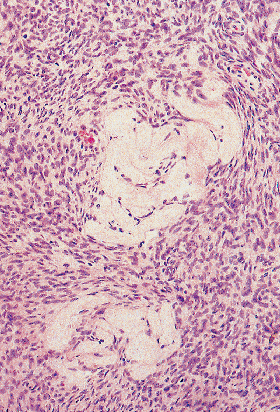 |
Figure 42.38 Two corpora fibrosa. |
Hilus Cells
Histology
Ovarian hilus cells, morphologically identical to testicular Leydig cells (with the exception of a female chromatin pattern), are present during fetal life but not during childhood. They reappear at the time of puberty and are demonstrable in most postmenopausal women (201,202,203). Their number and location can be highly variable, and their numbers increase during pregnancy, with increasing age after the menopause, and with increasing degrees of ovarian stromal proliferation and stromal luteinization (22). Mild hilus cell hyperplasia is a relatively common incidental histological finding in postmenopausal women (85).
 |
Figure 42.39 Nest of hilus cells adjacent to large vessel within the ovarian hilus. |
P.1087
Hilus cell aggregates of variable size and shape are typically found in the ovarian hilus and adjacent mesovarium (Figures 42.39, 42.40). They are more numerous in the lateral and medial poles of the hilus and near the junction of the ovarian ligament with the ovary, typically lying close to the junction of the hilus with the medullary stroma (Figure 42.40) (201). The aggregates are closely associated with large hilar veins and lymphatic sinusoids, and may form nodular protrusions into their lumina. Hilus cells characteristically ensheathe, or less commonly lie within, nonmedullated nerves (Figure 42.41), and occasionally surround the rete ovarii (201). Nests may also be present within the medullary stroma near the hilus, probably representing extensions of the hilus into the medulla. Also, as previously noted, cells of hilus-type may also occur rarely within the ovarian stroma at a distance from the hilus (stromal Leydig cells). Hilus cells also may be encountered rarely in the perisalpinx and fimbrial endosalpinx (204).
Hilus cells nests are unencapsulated, typically lying within loose connective tissue, or rarely ovarian-type stroma, within the hilus (101). The cells are 15 to 25 micra in diameter, round to oval, less commonly elongate, with abundant eosinophilic cytoplasm and a spherical vesicular nucleus with one or two prominent nucleoli (Figure 42.42). The nuclei, particularly in postmenopausal
P.1088
women, may have hyperchromatic, bizarre nuclei. Hilus cells are typically strongly immunoreactive for inhibin, calretinin, and melan-A (77,81).
 |
Figure 42.40 Nest of hilus cells with admixed small blood vessels abutting medullary stroma (top of figure). |
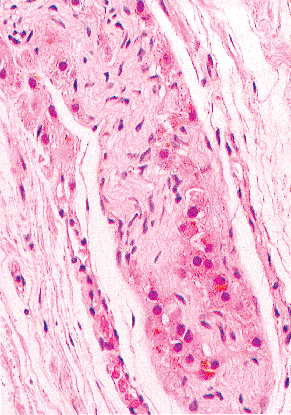 |
Figure 42.41 Perineural and intraneural hilus cells. Note fine brown lipochrome pigment within hilus cells. |
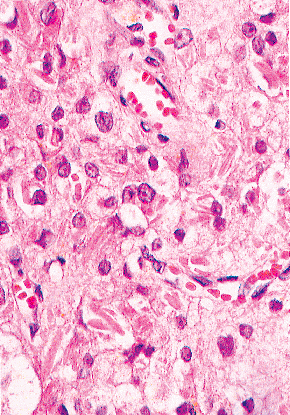 |
Figure 42.42 Hilus cells with Reinke crystals. |
Hilus cells contain specific crystals of Reinke, which are homogenous, eosinophilic, nonrefractile, rod-shaped structures, 10 to 35 m in length, with blunt, but occasionally tapered, ends (Figure 42.42). The crystals typically lie in a parallel or stacked arrangement within a cell, and often are surrounded by a clear halo; occasionally they appear to extend through or overlie cell membranes. The crystals are unevenly distributed and are typically present in only a minority of cells; frequently they cannot be identified (205). Their visualization may be facilitated by the use of Masson's trichrome and iron hematoxylin methods that stain them magenta and black respectively. Additionally, the crystals fluoresce yellow when H&E stained sections are viewed by ultraviolet light (206). Also present within hilus cells, often in greater numbers than crystals, are spherical or ellipsoidal hyalin structures that have an otherwise identical appearance to crystals and probably represent their precursors. Elongated erythrocytes compressed within capillaries should not be confused with crystals and crystal-precursors. The cytoplasm of Leydig cells may also contain perinuclear eosinophilic granules, peripheral lipid vacuoles, and golden-brown lipochrome pigment (Figure 42.41). Delicate collagen fibrils surround each cell. Typically admixed with the hilus cells are fibroblasts and cells intermediate in appearance between the two cell types (207). The hilus cells and intermediate cells have intimate attachments to nerves, including true synaptic connections, suggesting that hilus cells may originate from hilar fibroblasts, possibly under the inductive influence of hilar nerves (201,207).
Hilus cells should be distinguished from adrenal cortical rests. The latter are extremely rare in the ovary (208), but are found in the mesovarium, and occasionally within the ovarian hilus, in approximately one-quarter of women (209). Their histologic appearance mimics that of the normal adrenal cortex, with most of the cells containing numerous lipid vacuoles.
Ultrastructure
Hilus cells have a steroidogenic ultrastructure consisting of prominent smooth endoplasmic reticulum and mitochondria with tubular cristae, as well as well developed Golgi, large lysosomes, and osmiophilic lipid inclusions (207). Reinke crystals have a true crystalline appearance composed of dense parallel hexagonal microtubules with a mean thickness of 12 nm separated by clear spaces 15 nm wide producing a woven fabric appearance (Figure 42.43) (207). The crystals are typically oriented in many directions in the same cell. They appear to be formed by progressive association of precrystalline units each of which is composed of bundles of four or five parallel filaments (Figure 42.43).
Typically found admixed with hilus cells are fibroblasts and cells intermediate in ultrastructural appearance between the two cell types. Hilus cells, and more commonly the intermediate cells, have intimate attachments to nerves in the form of simple membranous contacts, invaginations of axon terminals into hilus cells, or surface membrane thickenings resembling a true synapse (207).
Hormonal Aspects
The light and electron microscopic morphology and enzyme content of hilus cells are those of steroid hormone-producing cells, although to what extent hilus cells contribute to the steroid hormone pool in normal females is unknown (32,201). In vitro incubation studies indicate that the major steroid produced by ovarian hilus cells is androstenedione and that it is produced in amounts higher than that produced from ovarian stroma (210). Lesser amounts of E2 and P are also produced in vitro. Hilus cells are responsive in vivo to both exogenous and endogenous hCG stimulation, manifested by an increase in their numbers, cell size, and mitotic activity (202).
 |
Figure 42.43 Reinke crystals with hexagonal internal pattern (CR) formed by association of precrystalline units (arrowheads); ser, smooth ER (original magnification x25,000). Reprinted with permission from: Laffargue P, Benkoel L, Laffargue F, Casanova P, Chamlian A. Ultrastructural and enzyme histochemical study of ovarian hilar cells in women and their relationships with sympathetic nerves. Hum Pathol 1978;9:649 659. |
P.1089
Rete Ovarii
The rete ovarii, the ovarian analog of the rete testis, is present in the hilus of all ovaries. It consists of a network of irregular clefts, tubules, cysts, and intraluminal papillae, lined by an epithelium that varies from flat to cuboidal to columnar (Figure 42.44) (211,212). Solid cords of similar cells may also be seen. Characteristically, the rete is surrounded by a cuff of spindle-cell stroma similar to, but discontinuous from, the ovarian stroma (Figure 42.44).
The cytoplasm of the cells of the rete is immunoreactive for cytokeratin, EMA, vimentin, and desmoplakin (35,36,213). Ultrastructural examination has revealed two types of cells, one ciliated and the other nonciliated with apical microvilli (35). The cytoplasm contains many mitochondria, a moderate amount of rough ER, many free polyribosomes, and some glycogen. Numerous desmosomes with associated tonofilament bundles connect adjacent cells. The basal lamina is well defined.
The rete juxtaposes and may communicate with mesonephric tubules within the mesovarium (212). Rare hilar cysts originate from the rete, and small tumorlike proliferations of the rete have been referred to as rete adenomas (212,214). The transitional cell metaplasia that has been encountered in the rete epithelium may account for the occasional small hilar Brenner tumors that have been contiguous with and possibly derived from the rete (211).
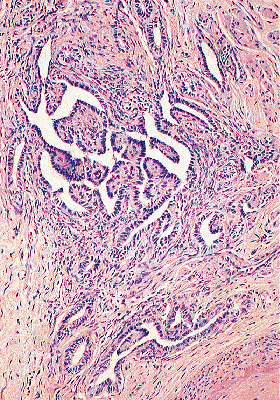 |
Figure 42.44 Rete ovarii. |
P.1090
References
1. Baker TG, Sum W. Development of the ovary and oogenesis. Clin Obstet Gynaecol 1976;3:3 26.
2. Hoang-Ngoc M, Smadja A, Herve De Sigalony JP, Orcel L. Etude histologique de la gonade a differenciation ovarienne au cours de l'organogenese. Arch Anat Cytol Pathol 1989;37:201 207.
3. Gondos B, Bhiraleus P, Hobel CJ. Ultrastructural observations on germ cells in human fetal ovaries. Am J Obstet Gynecol 1971;110:644 652.
4. Gondos B. Cellular interrelationships in the human fetal ovary and testis. In: Federoff S, ed. Prog Clin Biol Res. volume 59B. Eleventh International Congress of Anatomy: Advances in the Morphology of Cells and Tissues. New York: Alan R. Liss Inc; 1981:373 381.
5. Konishi I, Fujii S, Okamura H, Parmley T, Mori T. Development of interstitial cells and ovigerous cords in the human fetal ovary: an ultrastructural study. J Anat 1986;148:121 135.
6. Gondos B. Surface epithelium of the developing ovary. Possible correlation with ovarian neoplasia. Am J Pathol 1975;81:303 321.
7. Rabinovici J, Jaffe RB. Development and regulation of growth and differentiated function in human and subhuman primate fetal gonads. Endocr Rev 1990;11:532 557.
8. Van Wagenen G, Simpson ME. Embryology of the Ovary and Testis in Homo Sapiens and Macaca Mulatta. New Haven: Yale University Press; 1965.
9. Fukuda O, Miyayama Y, Fujimoto T, et al. Electron microscopic study of the gonadal development in early human embryos. Prog Clin Biol Res 1989;296:23 29.
10. Pinkerton JH, McKay DG, Adams EC, Hertig AT. Development of the human ovary a study using histochemical techniques. Obstet Gynecol 1961;18:152 181.
11. Gruenwald P. The development of the sex cords in the gonads of man and mammals. Am J Anat 1942;70:359 389.
12. Jirasek JE. Development of the genital system in human embryos and fetuses. In: Jirasek J. Development of the Genital System and Male Pseudohermaphroditism. Baltimore: Johns Hopkins Press; 1971:3 41.
13. Byskov AG. Differentiation of mammalian embryonic gonad. Physiol Rev 1986;66:71 117.
14. Satoh M. Histogenesis and organogenesis of the gonad in human embryos. J Anat 1991;177:85 107.
15. Wartenberg H. The influence of the mesonephric blastema on gonadal development and sexual differentiation. In: Byskov AG, Peters H, eds. Development and Function of Reproductive Organs. Amsterdam-Oxford-Princeton: Excerpta Medica; 1981:3 12.
16. Wartenberg H. Development of the early human ovary and role of the mesonephros in the differentiation of the cortex. Anat Embryol (Berl) 1982;165:253 280.
17. Nicosia SV. Morphological changes in the human ovary throughout life. In: Serra GB, ed. The Ovary. New York: Raven Press; 1983:57 81.
18. Pryse-Davies J. The development, structure and function of the female pelvic organs in childhood. Clin Obstet Gynaecol 1974;1:483 508.
19. Valdes-Dapena MA. The normal ovary of childhood. Ann N Y Acad Sci 1967;142:597 613.
20. Merrill JA. The morphology of the prepubertal ovary: relationship to the polycystic ovary syndrome. South Med J 1963;56:225 231.
21. Pavlik EJ, DePriest PD, Gallion HH, et al. Ovarian volume related to age. Gynecol Oncol 2000;77:410 412.
22. Boss JH, Scully RE, Wegner KH, Cohen RB. Structural variations in the adult ovary. Clinical significance. Obstet Gynecol 1965;25:747 764.
23. Reeves G. Specific stroma in the cortex and medulla of the ovary. Cell types and vascular supply in relation to follicular apparatus and ovulation. Obstet Gynecol 1971;37:832 844.
24. Plentl AA, Friedman EA. Lymphatic System of the Female Genitalia. Philadelphia: WB Saunders; 1971.
25. Eichner E, Bove ER. In vivo studies on the lymphatic drainage of the human ovary. Obstet Gynecol 1954;3:287 297.
26. Jacobowitz D, Wallach EE. Histochemical and chemical studies of the autonomic innervation of the ovary. Endocrinology 1967;81:1132 1139.
27. Owman C, Rosenbren E, Sjoberg N. Adrenergic innervation of the human female reproductive organs: a histochemical and chemical investigation. Obstet Gynecol 1967;30:763 773.
28. Balboni GC. Structural changes: ovulation and luteal phase. In: Serra GB, ed. The Ovary. New York: Raven Press; 1983:123 141.
29. Mohsin S. The sympathetic innervation of the mammalian ovary. A review of pharmacological and histochemical studies. Clin Exp Pharmacol Physiol 1979;6:335 354.
30. Dyer CA, Erickson GF. Norepinephrine amplifies human chorionic gonadotropin-stimulated androgen biosynthesis by ovarian theca-interstitial cells. Endocrinology 1985;116:1645 1652.
31. Blaustein A, Lee H. Surface cells of the ovary and pelvic peritoneum: a histochemical and ultrastructural comparison. Gynecol Oncol 1979;8:34 43.
32. McKay DG, Pinkerton JH, Hertig AT, Danzinger S. The adult human ovary: a histochemical study. Obstet Gynecol 1961;18:13 39.
33. Miettinen M, Lehto V, Virtanen I. Expression of intermediate filaments in normal ovaries and ovarian epithelial, sex cord-stromal, and germinal tumors. Int J Gynecol Pathol 1983;2:64 71.
34. Czernobilsky B, Moll R, Franke WW, Dallenbach-Hellweg G, Hohlweg-Majert P. Intermediate filaments of normal and neoplastic tissues of the female genital tract with emphasis on problems of differential tumor diagnosis. Pathol Res Pract 1984;179:31 37.
35. Czernobilsky B, Moll R, Levy R, Franke WW. Co-expression of cytokeratin and vimentin filaments in mesothelial, granulosa and rete ovarii cells of the human ovary. Eur J Cell Biol 1985;37:175 190.
36. Benjamin E, Law S, Bobrow LG. Intermediate filaments cytokeratin and vimentin in ovarian sex cord-stromal tumours with correlative studies in adult and fetal ovaries. J Pathol 1987;152:253 263.
37. Isola J, Kallioniemi OP, Korte JM, et al. Steroid receptors and Ki-67 reactivity in ovarian cancer and in normal ovary: correlation with DNA flow cytometry, biochemical receptor assay, and patient survival. J Pathol 1990;162:295 301.
38. Rodriguez GC, Berchuk A, Whitaker RS, Schlossman D, Clarke-Pearson DL, Bast RC Jr. Epidermal growth factor receptor expression in normal ovarian epithelium and ovarian cancer. II. Relationship between receptor expression and response to epidermal growth factor. Am J Obstet Gynecol 1991;164:745 750.
39. Jindal SK, Snoey DM, Lobb DK, Dorrington JH. Transforming growth factor alpha localization and role in surface epithelium of normal human ovaries and in ovarian carcinoma lines. Gynecol Oncol 1994;53:17 23.
40. Latza U, Niedobitek G, Schwarting R, Nekarda H, Stein H. Ber-EP4: new monoclonal antibody which distinguishes epithelia from mesothelial. J Clin Pathol 1990;43:213 219.
41. Shimizu M, Toki T, Takagi Y, Konishi I, Fujii S. Immunohistochemical detection of the Wilms' tumor gene (WT1) in epithelial ovarian tumors. Int J Gynecol Pathol 2000;19:158 163.
42. Carreiras F, Denoux Y, Staedel C, Sichel F, Gauduchon P. Expression and localization of v integrins and their ligand vitronectin in normal ovarian epithelium and in ovarian carcinoma. Gynecol Oncol 1996;62:260 267.
43. Zheng W, Magid MS, Kramer EE, Chen YT. Follicle-stimulating hormone receptor is expressed in human ovarian surface epithelium and fallopian tube. Am J Pathol 1996;148:47 53.
44. Davies BR, Worsley SD, Ponder BA. Expression of E-cadherin, -catenin and -catenin in normal ovarian surface epithelium and epithelial ovarian cancers. Histopathology 1998;32:69 80.
45. Cruet S, Salamanca C, Mitchell GW, Auersperg N. v 3 and vitronectin expression by normal ovarian surface epithelial cells: role in cell adhesion and cell proliferation. Gynecol Oncol 1999;75:254 260.
46. Cao QJ, Jones JG, Li M. Expression of calretinin in human ovary, testis, and ovarian sex cord-stromal tumors. Int J Gynecol Pathol 2001;20:346 352.
47. Blaustein A. Surface cells and inclusion cysts in fetal ovaries. Gynecol Oncol 1981;12(pt 1):222 233.
P.1091
48. Blaustein A, Kantius M, Kaganowicz A, Pervez N, Wells J. Inclusions in ovaries of females aged day 1-30 years. Int J Gynecol Pathol 1982;1:145 153.
49. Zinsser KR, Wheeler JE. Endosalpingiosis in the omentum: a study of autopsy and surgical material. Am J Surg Pathol 1982;6:109 117.
50. Mulligan RM. A survey of epithelial inclusions in the ovarian cortex of 470 patients. J Surg Oncol 1976;8:61 66.
51. Von Numers C. Observations on metaplastic changes in the germinal epithelium of the ovary and on the aetiology of ovarian endometriosis. Acta Obstet Gynecol Scand 1965;44:107 116.
52. Scully RE. Ovary. In: Henson DE, Albores-Saavedra J, eds. The Pathology of Incipient Neoplasia. Major Problems in Pathology Series. 2nd ed. Vol 28. Philadelphia: WB Saunders; 1993:279 300.
53. Mittal KR, Zeleniuch-Jacquotte A, Cooper JL, Demopoulos RI. Contralateral ovary in unilateral ovarian carcinoma: a search for preneoplastic lesions. Int J Gynecol Pathol 1993;12:59 63.
54. Hutson R, Ramsdale J, Wells M. p53 protein expression in putative precursor lesions of epithelial ovarian cancer. Histopathology 1995;27:367 371.
55. Blaustein A, Kaganowicz A, Wells J. Tumor markers in inclusion cysts of the ovary. Cancer 1982;49:722 726.
56. Charpin C, Bhan AK, Zurawski VR Jr, Scully RE. Carcinoembryonic antigen (CEA) and carbohydrate determinant 19-9 (CA 19-9) localization in 121 primary and metastatic ovarian tumors: an immunohistochemical study with the use of monoclonal antibodies. Int J Gynecol Pathol 1982;1:231 245.
57. Cordon-Cardo C, Mattes MJ, Melamed MR, Lewis JL Jr, Old LJ, Lloyd KO. Immunopathologic analysis of a panel of mouse monoclonal antibodies reacting with human ovarian carcinomas and other human tumors. Int J Gynecol Pathol 1985;4:121 130.
58. Kabawat SE, Bast RC Jr, Bhan AK, Welch WR, Knapp RC, Colvin RB. Tissue distribution of coelomic-epithelium-related antigen recognized by the monoclonal antibody OC125. Int J Gynecol Pathol 1983;2:275 285.
59. Nouwen EJ, Pollet DE, Schelstraete JB, et al. Human placental alkaline phosphatase in benign and malignant ovarian neoplasia. Cancer Res 1985;45:892 902.
60. Nouwen EJ, Hendrix PG, Dauwe S, Eerdekens MW, De Broe ME. Tumor markers in the human ovary and its neoplasms. A comparative immunohistochemical study. Am J Pathol 1987;126:230 242.
61. Mittal KR, Goswami S, Demopoulos RI. Immunohistochemical profile of ovarian inclusion cysts in patients with and without ovarian carcinoma. Histochem J 1995;27:119 122.
62. Maines-Bandiera SL, Auersperg N. Increased E-cadherin expression in ovarian surface epithelium: an early step in metaplasia and dysplasia? Int J Gynecol Pathol 1997;16:250 255.
63. Sundfeldt K, Piontkewitz Y, Ivarsson K, et al. E-cadherin expression in human epithelial ovarian cancer and normal ovary. Int J Cancer 1997;74:275 280.
64. Resta L, Scordari MD, Colucci GA, et al. Morphological changes of the ovarian surface epithelium in ovarian polycystic disease or endometrial carcinoma and a control group. Eur J Gynaecol Oncol 1989;10:39 41.
65. Bransilver BR. Ferenczy A, Richart RM. Brenner tumors and Walthard cell nests. Arch Pathol 1974;98:76 86.
66. Danforth DN. Cytologic relationship of Walthard cell rest to Brenner tumor of ovary and the pseudomucinous cystadenoma. Am J Obstet Gynecol 1942;43:984 996.
67. Roth LM. The Brenner tumor and the Walthard cell nest. An electron microscopic study. Lab Invest 1974;31:15 23.
68. Teoh TB. The structure and development of Walthard nests. J Pathol Bacteriol 1953;66:433 439.
69. Papadaki L, Beilby JO. The fine structure of the surface epithelium of the human ovary. J Cell Sci 1971;8:445 465.
70. Ferenczy A, Richart RM. Female Reproductive System: Dynamics of Scan and Transmission Electron Microscopy. New York: John Wiley & Sons; 1974.
71. Blaustein A. Peritoneal mesothelium and ovarian surface cells shared characteristics. Int J Gynecol Pathol 1984;3:361 375.
72. Fienberg R, Cohen RB. A comparative histochemical study of the ovarian stromal lipid band, stromal theca cell, and normal ovarian follicular apparatus. Am J Obstet Gynecol 1965;92:958 969.
73. Czernobilsky B, Shezen E, Lifschitz-Mercer B, et al. Alpha smooth muscle actin (alpha-SM actin) in normal human ovaries, in ovarian stromal hyperplasia and in ovarian neoplasms. Virchows Arch B Cell Pathol Incl Mol Pathol 1989;57:55 61.
74. Lastarria D, Sachdev RK, Babury RA, Yu HM, Nuovo GJ. Immunohistochemical analysis for desmin in normal and neoplastic ovarian stromal tissue. Arch Pathol Lab Med 1990;114:502 505.
75. Matias-Guiu X, Pons C, Prat J. Mullerian inhibiting substance, alpha-inhibin, and CD99 expression in sex cord-stromal tumors and endometrioid ovarian carcinomas resembling sex cord-stromal tumors. Hum Pathol 1998;29:840 845.
76. Rishi M, Howard LN, Bratthauer GL, Tavassoli FA. Use of monoclonal antibody against human inhibin as a marker for sex cord-stromal tumors of the ovary. Am J Surg Pathol 1997;21:583 589.
77. Pelkey TJ, Frierson HF Jr, Mills SE, Stoler MH. The diagnostic utility of inhibin staining in ovarian neoplasms. Int J Gynecol Pathol 1998;17:97 105.
78. Zheng W, Sung CJ, Hanna I, et al. and subunits of inhibin/activin as sex cord-stromal differentiation markers. Int J Gynecol Pathol 1997;16:263 271.
79. Hildebrandt RH, Rouse RV, Longacre TA. Value of inhibin in the identification of granulosa cell tumors of the ovary. Hum Pathol 1997;28:1387 1395.
80. McCluggage WG, Maxwell P. Immunohistochemical staining for calretinin is useful in the diagnosis of ovarian sex cord-stromal tumours. Histopathology 2001;38:403 408.
81. Jungbluth AA, Busam KJ, Gerald WL, et al. A103: An anti-melan-a monoclonal antibody for the detection of malignant melanoma in paraffin-embedded tissues. Am J Surg Pathol 1998;22:595 602.
82. Oliva E, Vu Q, Young RH. CD10 expression in sex cord-stromal tumors (SCTs) and steroid cell tumors (StCTs) of the ovary. Mod Pathol 2002;15:204A.
83. Nagamani M, Hannigan EV, Dinh TV, Stuart CA. Hyperinsulinemia and stromal luteinization of the ovaries in postmenopausal women with endometrial cancer. J Clin Endocrinol Metab 1988; 67:144 148.
84. Scully RE, Cohen RB. Oxidative-enzyme activity in normal and pathologic human ovaries. Obstet Gynecol 1964;24:667 681.
85. Loubet R, Loubet A, Leboutet MJ. The ovarian stroma after the menopause: activity and ageing. In: de Brux J, Gautray JP, eds. Clinical Pathology of the Ovary. Boston: MTP Press Ltd; 1984:119 141.
86. Nakano R, Shima K, Yamoto M, Kobayashi M, Nishimori K, Hiraoka J. Binding sites for gonadotropins in human postmenopausal ovaries. Obstet Gynecol 1989;73:196 200.
87. Bassis ML. Pseudodeciduosis. Am J Obstet Gynecol 1956;72:1029 1037.
88. Israel SL, Rubenstone A, Meranze DR. The ovary at term. I. Decidua-like reaction and surface cell proliferation. Obstet Gynecol 1954;3:399 407.
89. Ober WB, Grady HG, Schoenbucher AK. Ectopic ovarian decidua without pregnancy. Am J Pathol 1957;33:199 217.
90. Bersch W, Alexy E, Heuser HP, et al. Ectopic decidua formation in the ovary (so-called deciduoma). Virch Archiv A 1973;360:173 177.
91. Starup J, Visfeldt J. Ovarian morphology in early and late human pregnancy. Acta Obstet Gynecol Scand 1974;53:211 218.
92. Herr JC, Heidger PM Jr, Scott JR, Anderson JW, Curet LB, Mossman HW. Decidual cells in the human ovary at term. I. Incidence, gross anatomy and ultrastructural features of merocrine secretion. Am J Anat 1978;152:7 27.
93. Doss BJ, Wanek SM, Jacques SM, Qureshi F, Ramirez NC, Lawrence WD. Ovarian smooth muscle metaplasia: an uncommon and possibly underrecognized entity. Int J Gynecol Pathol 1999;18:58 62.
94. Hughesdon PE. Morphology and morphogenesis of the Stein-Leventhal ovary and of so-called hyperthecosis. Obstet Gynecol Surv 1982;37:59 77.
95. Scully RE. Smooth-muscle differentiation in genital tract disorders. Arch Pathol Lab Med 1981;105:505 507.
96. Hughesdon PE. The origin and development of benign stromatosis of the ovary. J Obstet Gynaecol Br Commonw 1972;79:348 359.
P.1092
97. Hughesdon PE. The endometrial identity of benign stromatosis of the ovary and its relation to other forms of endometriosis. J Pathol 1976;119:201 209.
98. Hart WR, Abell MR. Adipose prosoplasia of ovary. Am J Obstet Gynecol 1970;106:929 931.
99. Honor LH, O'Hara KE. Subcapsular adipocytic infiltration of the human ovary: a clinicopathological study of eight cases. Eur J Obstet Gynaecol Reprod Biol 1980;10:13 20.
100. Sternberg WH, Roth LM. Ovarian stromal tumors containing Leydig cells. I. Stromal-Leydig cell tumor and non-neoplastic transformation of ovarian stroma to Leydig cells. Cancer 1973;32:940 951.
101. Zhang J, Young RH, Arseneau J, Scully RE. Ovarian stromal tumors containing lutein or Leydig cells (luteinized thecomas and stromal Leydig cell tumors) a clinicopathological analysis of fifty cases. Int J Gynecol Pathol 1982;1:270 285.
102. Rutgers JL, Scully RE. Functioning ovarian tumors with peripheral steroid cell proliferation: a report of twenty-four cases. Int J Gynecol Pathol 1986;5:319 337.
103. Hidvegi D, Cibils LA, Sorensen K, Hidvegi I. Ultrastructural and histochemical observations of neuroendocrine granules in nonneoplastic ovaries. Am J Obstet Gynecol 1982;143:590 594.
104. Snowden JA, Harkin PJ, Thornton JG, Wells M. Morphometric assessment of ovarian stromal proliferation a clinicopathological study. Histopathology 1989;14:369 379.
105. Bigelow B. Comparison of ovarian and endometrial morphology spanning the menopause. Obstet Gynecol 1958;11:487 513.
106. Roddick JW Jr, Greene RR. Relation of ovarian stromal hyperplasia to endometrial carcinoma. Am J Obstet Gynecol 1957;73:843 852.
107. Woll E, Hertig AT, Smith GVS, Johnson LC. The ovary in endometrial carcinoma: with notes on the morphological history of the aging ovary. Am J Obstet Gynecol 1948;56:617 633.
108. Laffargue P, Adechy-Benkoel L, Valette C. Ultrastructure du stroma ovarien. Ann d'Anat Pathol 1968;13:381 402.
109. Aiman J, Forney JP, Parker CR Jr. Secretion of androgens and estrogens by normal and neoplastic ovaries in postmenopausal women. Obstet Gynecol 1986;68:1 5.
110. Chang RJ, Judd HL. The ovary after menopause. Clin Obstet Gynaecol 1981;24:181 191.
111. Dennefors BL, Janson PO, Knutson F, Hamberger L. Steroid production and responsiveness to gonadotropin in isolated stromal tissue of human postmenopausal ovaries. Am J Obstet Gynecol 1980;136:997 1002.
112. Greenblatt RB, Colle ML, Mahesh VB. Ovarian and adrenal steroid production in the postmenopausal woman. Obstet Gynecol 1976;47:383 387.
113. Judd HL, Judd GE, Lucas WE, Yen SS. Endocrine function of the postmenopausal ovary: concentration of androgens and estrogens in ovarian and peripheral vein blood. J Clin Endocrinol Metab 1974;39:1020 1024.
114. Judd HL, Lucas WE, Yen SSC. Effect of oophorectomy on circulating testosterone and androstenedione levels in patients with endometrial cancer. Am J Obstet Gynecol 1974;118:793 798.
115. Longcope C, Hunter R, Franz C. Steroid secretion by the postmenopausal ovary. Am J Obstet Gynecol 1980;138:564 568.
116. Lucisano A, Russo N, Acampora MG, et al. Ovarian and peripheral androgen and oestrogen levels in post-menopausal women: correlations with ovarian histology. Maturitas 1986;8:57 65.
117. Mattingly RF, Huang WY. Steroidogenesis of the menopausal and postmenopausal ovary. Am J Obstet Gynecol 1969;103:679 693.
118. McNatty KP, Makris A, DeGrazia C, Osathanondh R, Ryan KJ. The production of progesterone, androgens, and estrogens by granulosa cells, thecal tissue, and stromal tissue from human ovaries in vitro. J Clin Endocrinol Metab 1979;49:687 699.
119. McNatty KP, Smith DM, Makris A, et al. The intraovarian sites of androgen and estrogen formation in women with normal and hyperandrogenic ovaries as judged by in vitro experiments. J Clin Endocrinol Metab 1980;50:755 763.
120. Plotz EJ, Wiener M, Stein AA, Hahn BD. Enzymatic activities related to steroidogenesis in postmenopausal ovaries of patients with and without endometrial carcinoma. Am J Obstet Gynecol 1967;99:182 197.
121. Vermeulen A. The hormonal activity of the postmenopausal ovary. J Clin Endocrinol Metab 1976;42:247 253.
122. Rice BF, Savard K. Steroid hormone formation in the human ovary. IV. Ovarian stromal compartment; formation of radioactive steroids from acetate-1-14C and action of gonadotropins. J Clin Endocrinol Metab 1966;26:593 609.
123. Barbieri RL, Makris A, Randall RW, Daniels G, Kistner RW, Ryan KJ. Insulin stimulates androgen accumulation in incubations of ovarian stroma obtained from women with hyperandrogenism. J Clin Endocrinol Metab 1986;62:904 910.
124. Reed MJ, Beranek PA, Ghilchik MW, James VH. Conversion of estrone to estradiol and estradiol to estrone in postmenopausal women. Obstet Gynecol 1985;66:361 365.
125. Longcope C. Metabolic clearance and blood production rates of estrogens in postmenopausal women. Am J Obstet Gynecol 1971;111:778 781.
126. Grodin JM, Siiteri PK, MacDonald PC. Source of estrogen production in postmenopausal women. J Clin Endocrinol Metab 1973;36:207 214.
127. Nagamani M, Stuart CA, Doherty MG. Increased steroid production by the ovarian stromal tissue of postmenopausal women with endometrial cancer. J Clin Endocrinol Metab 1992;74:172 176.
128. Dawood MY, Strongin M, Kramer EE, Wieche R. Recent ovulation in a postmenopausal woman. Int J Gynaecol Obstet 1980;18:192 194.
129. Sherrer C, Gerson B, Woodruff JD. The incidence and significance of polynuclear follicles. Am J Obstet Gynecol 1977;128:6 12.
130. Gougeon A. Frequent occurrence of multiovular follicles and multinuclear oocytes in the adult human ovary. Fertil Steril 1981;35:417 422.
131. Manivel JC, Dehner LP, Burke B. Ovarian tumorlike structures, biovular follicles, and binucleated oocytes in children: their frequency and possible pathologic significance. Pediatr Pathol 1988;8:283 292.
132. Baca M, Zamboni L. The fine structure of the human follicular oocytes. J Ultrastruct Res 1967;19:354 381.
133. Hertig AT. The primary human oocyte: some observations on the fine structure of Balbiani's vitelline body and the origin of the annulate lamellae. Am J Anat 1968;122:107 137.
134. Hertig AT, Adams EC. Studies on the human oocyte and its follicle. I. Ultrastructural and histochemical observations on the primordial follicle stage. J Cell Biol 1967;34:647 675.
135. Curtis EM. Normal ovarian histology in infancy and childhood. Obstet Gynecol 1962;19:444 454.
136. Dekel N, David MP, Yedwab GA, Kraicer PF. Follicular development during late pregnancy. Int J Fertil 1977;22:24 29.
137. Govan ADT. Ovarian follicular activity in late pregnancy. J Endocrinol 1970;48:235 241.
138. Himelstein-Braw R, Byskov AG, Peters H, Faber M. Follicular atresia in the infant human ovary. J Reprod Fertil 1976;46:55 59.
139. Maqueo M, Goldzieher JW. Hormone-induced alterations of ovarian morphology. Fertil Steril 1966;17:676 683.
140. Mikhail G, Allen WM. Ovarian function in human pregnancy. Am J Obstet Gynecol 1967;99:308 312.
141. Nelson WW, Greene RR. The human ovary in pregnancy. Int Abstr Surg 1953;97:1 22.
142. Nelson WW, Greene RR. Some observations on the histology of the human ovary during pregnancy. Am J Obstet Gynecol 1958;76:66 90.
143. Peters H, Himelstein-Braw R, Faber M. The normal development of the ovary in childhood. Acta Endocrinol (Copenh) 1976;82:617 630.
144. McNatty KP, Hillier SG, van den Boogaard AM, Trimbos-Kemper TC, Reichert LE Jr, van Hall EV. Follicular development during the luteal phase of the human menstrual cycle. J Clin Endocrinol Metab 1983;56:1022 1031.
145. McNatty KP, Smith DM, Makris A, Osathanondh R, Ryan KJ. The microenvironment of the human antral follicle: interrelationships among the steroid levels in antral fluid, the population of granulosa cells, and the status of the oocyte in vivo and in vitro. J Clin Endocrinol Metab 1979;49:851 860.
P.1093
146. White RF, Hertig AT, Rock J, Adams E. Histological and histochemical observations on the corpus luteum of human pregnancy with special reference to corpora lutea associated with early normal and abnormal ova. Contrib Embryol 1951;34:55 74.
147. Jones GE, Goldberg B, Woodruff JD. Histochemistry as a guide for interpretation of cell function. Am J Obstet Gynecol 1968;100:76 83.
148. Sasano H, Mori T, Sasano N, Nagura H, Mason JI. Immunolocalization of 3 beta-hydroxysteroid dehydrogenase in human ovary. J Reprod Fertil 1990;89:743 751.
149. Deane HW, Lobel BL, Romney SL. Enzymic histochemistry of normal human ovaries of the menstrual cycle, pregnancy, and the early puerperium. Am J Obstet Gynecol 1962;83:281 294.
150. Mestwerdt W, Muller O, Brandau H. Structural analysis of granulosa cells from human ovaries in correlation with function. In: Channing CP, Marsh JM, Sadler WA, eds. Ovarian Follicular and Corpus Luteum Function: Advances in Experimental Medicine and Biology. Vol 112. New York: Plenum Press; 1978.
151. Gillim SW, Christensen AK, McLennan CE. Fine structure of the human menstrual corpus luteum at its stage of maximum secretory activity. Am J Anat 1969;126:409 427.
152. Okamura H, Virutamasen P, Wright KH, Wallach EE. Ovarian smooth muscle in the human being, rabbit, and cat. Histochemical and electron microscopic study. Am J Obstet Gynecol 1972;112:183 191.
153. McNatty KP. Follicular determinants of corpus luteum function in the human ovary. In: Channing CP, Marsh JM, Sadler WA, eds. Ovarian Follicular and Corpus Luteum Function: Advances in Experimental Medicine and Biology. Vol 112. New York: Plenum Press; 1978:465 477.
154. McNatty KP. Cyclic changes in antral fluid hormone concentrations in humans. Clin Endocrinol Metab 1978;7:577 600.
155. Erickson GF. Normal ovarian function. Clin Obstet Gynecol 1978; 21:31 52.
156. Shima K, Kitayama S, Nakano R. Gonadotropin binding sites in human ovarian follicles and corpora lutea during the menstrual cycle. Obstet Gynecol 1987;69:800 806.
157. Eden JA, Carter GD, Jones J, Alaghband-Zadeh J. Insulin-like growth factor 1 as an intra-ovarian hormone an integrated hypothesis and review. Aust N Z J Obstet Gynaecol 1989;29:30 37.
158. McNatty KP, Makris A, De Grazia C, Osathanondh R, Ryan KJ. The production of progesterone, androgens and oestrogens by human granulosa cells in vitro and in vivo. J Steroid Biochem 1979;11:775 779.
159. Hillier SG. Intrafollicular paracrine function of ovarian androgen. J Steroid Biochem 1987;27:351 357.
160. Pauerstein CJ, Eddy CA, Croxatto HD, Hess R, Siler-Khodr TM, Croxatto HB. Temporal relationships of estrogen, progesterone, and luteinizing hormone levels to ovulation in women and infrahuman primates. Am J Obstet Gynecol 1978;130:876 886.
161. Yussman MA, Taymor ML. Serum levels of follicle stimulating hormone and luteinizing hormone and of plasma progesterone related to ovulation by corpus luteum biopsy. J Clin Endocrinol Metab 1970;30:396 399.
162. Futterweit W. Polycystic Ovarian Disease: Clinical Perspectives in Obstetrics and Gynecology. New York: Springer-Verlag; 1985.
163. Tanabe K, Gagliano P, Channing CP, et al. Levels of inhibin-F activity and steroids in human follicular fluid from normal women and women with polycystic ovarian disease. J Clin Endocrinol Metab 1983;57:24 31.
164. Tsonis CG, Messinis IE, Templeton AA, McNeilly AS, Baird DT. Gonadotropic stimulation of inhibin secretion by the human ovary during the follicular and early luteal phase of the cycle. J Clin Endocrinol Metab 1988;66:915 921.
165. McLachlan RI, Cohen NL, Vale WW, et al. The importance of luteinizing hormone in the control of inhibin and progesterone secretion by the human corpus luteum. J Clin Endocrinol Metab 1989;68:1078 1085.
166. Sealey JE, Glorioso N, Itskovitz J, Laragh JH. Prorenin as a reproductive hormone. New form of the renin system. Am J Med 1986;81:1041 1046.
167. Palumbo A, Jones C, Lightman A, Carcangiu ML, DeCherney AH, Naftolin F. Immunohistochemical localization of renin and angiotensin II in human ovaries. Am J Obstet Gynecol 1989;160:8 14.
168. Corner GW Jr. The histological dating of the human corpus luteum of menstruation. Am J Anat 1956;98:377 401.
169. Visfeldt J, Starup J. Dating of the human corpus luteum of menstruation using histological parameters. Acta Pathol Microbiol Scand A 1974;82:137 144.
170. Croxatto HD, Ortiz ME, Croxatto HB. Correlation between histologic dating of human corpus luteum and the luteinizing hormone peak biopsy interval. Am J Obstet Gynecol 1980;136:667 670.
171. Wiley CA, Esterly JR. Observations on the human corpus luteum: histochemical changes during development and involution. Am J Obstet Gynecol 1976;125:514 519.
172. Hameed A, Fox WM, Kurman RJ, Hruban RH, Podack ER. Perforin expression in human cell-mediated luteolysis. Int J Gynecol Pathol 1995;14:151 157.
173. Adams EC, Hertig AT. Studies on the human corpus luteum. I. Observations on the ultrastructure of development and regression of the luteal cells during the menstrual cycle. J Cell Biol 1969;41:696 715.
174. Tamura M, Sasano H, Suzuki T, et al. Immunohistochemical localization of growth hormone receptor in cyclic human ovaries. Hum Reprod 1994;9:2259 2262.
175. Crisp TM, Dessouky DA, Denys FR. The fine structure of the human corpus luteum of early pregnancy and during the progestational phase of the menstrual cycle. Am J Anat 1970;127:37 69.
176. Green JA, Maqueo M. Ultrastructure of the human ovary. I. The luteal cell during the menstrual cycle. Am J Obstet Gynecol 1965;92:946 957.
177. LeMaire WJ, Conly PW, Moffett A, Spellacy WN, Cleveland WW, Savard K. Function of the human corpus luteum during the puerperium: its maintenance by exogenous human chorionic gonadotropin. Am J Obstet Gynecol 1971;110:612 618.
178. Centola GM. Structural changes: follicular development and hormonal requirements. In: Serra GB, ed. The Ovary. New York: Raven Press; 1983:95 111.
179. Rao CV. Receptors for gonadotropins in human ovaries. In: Muldoon T, Mahesh V, Perez-Ballester B, eds. Recent Advances in Fertility Research Part A: Developments in Reproductive Endocrinology. New York: Alan R. Liss; 1982:123 135.
180. Vijayakumar R, Walters WA. Ovarian stromal and luteal tissue prostaglandins, 17beta-estradiol and progesterone in relation to the phases of the menstrual cycle in woman. Am J Obstet Gynecol 1987;156:947 951.
181. Hertig AT. Gestational hyperplasia of endometrium. A morphologic correlation ova, endometrium, and corpora lutea during early pregnancy. Lab Invest 1964;13:1153 1191.
182. Visfeldt J, Starup J. Histology of the human corpus luteum of early and late pregnancy. Acta Pathol Microbiol Scand A 1975;83:669 677.
183. Adams EC, Hertig AT. Studies on the human corpus luteum. II. Observations on the ultrastructure of luteal cells during pregnancy. J Cell Biol 1969;41:716 735.
184. Green JA, Garcilazo JA, Maqueo M. Ultrastructure of the human ovary. II. The luteal cell at term. Am J Obstet Gynecol 1967;99:855 863.
185. Pedersen PH, Larsen JF. The ultrastructure of the human granulosa lutein cell of the first trimester of gestation. Acta Endocrinol (Copenh) 1968;58:481 496.
186. Le Maire WJ, Rice BF, Savard K. Steroid hormone formation in the human ovary: V. Synthesis of progesterone in vitro in corpora lutea during the reproductive cycle. J Clin Endocrinol Metab 1968;28:1249 1256.
187. Weiss G, Rifkin I. Progesterone and estrogen secretion by puerperal human ovaries. Obstet Gynecol 1975;46:557 559.
188. Weiss G, O'Byrne M, Hochman JA, Goldsmith LT, Rifkin I, Steinetz BG. Secretion of progesterone and relaxin by the human corpus luteum at midpregnancy and at term. Obstet Gynecol 1977;50:679 681.
189. Weiss G, O'Byrne EM, Steinetz BG. Relaxin: a product of human corpus luteum of pregnancy. Science 1976;194:948 949.
P.1094
190. Schmidt CL, Black VH, Sarosi P, Weiss G. Progesterone and relaxin secretion in relation to the ultrastructure of human luteal cells in culture: effects of human chorionic gonadotropin. Am J Obstet Gynecol 1986;155:1209 1219.
191. Quagliarello J, Goldsmith L, Steinetz B, Lustig DS, Weiss G. Induction of relaxin secretion in nonpregnant women by human chorionic gonadotropin. J Clin Endocrinol Metab 1980;51:74 77.
192. Joel RV, Foraker AG. Fate of the corpus albicans: a morphologic approach. Am J Obstet Gynecol 1960;80:314 316.
193. Reagan JW. Ceroid pigment in the human ovary. Am J Obstet Gynecol 1950;59:433 436.
194. Centola GM. Structural changes: atresia. In: Serra GB, ed. The Ovary. New York: Raven Press; 1983:113 122.
195. Strickler RC, Kelly RW, Askin FB. Postmenopausal ovarian follicle cyst: an unusual cause of estrogen excess. Int J Gynecol Pathol 1984;3:318 322.
196. Kraus FT, Neubecker RD. Luteinization of the ovarian theca in infants and children. Am J Clin Pathol 1962;37:389 397.
197. Clement PB, Young RH, Scully RE. Ovarian granulosa cell proliferations of pregnancy: a report of nine cases. Hum Pathol 1988;19:657 662.
198. Kedzia H. Gonadoblastoma: structures and background of development. Am J Obstet Gynecol 1983;147:81 85.
199. Safneck JR, deSa DJ. Structures mimicking sex cord-stromal tumours and gonadoblastomas in the ovaries of normal infants and children. Histopathology 1986;10:909 920.
200. Bomsel-Helmreich O, Gougeon A, Thebault A, et al. Healthy and atretic human follicles in the preovulatory phase: differences in evolution of follicular morphology and steroid content of follicular fluid. J Clin Endocrinol Metab 1979;48:686 694.
201. Sternberg WH. The morphology, androgenic function, hyperplasia, and tumors of the human ovarian hilus cells. Am J Pathol 1949;25:493 521.
202. Sternberg WH, Segaloff A, Gaskill CJ. Influence of chorionic gonadotropin on human ovarian hilus cells, Leydig-like cells. J Clin Endocrinol Metab 1953;13:139 153.
203. Merrill JA. Ovarian hilus cells. Am J Obstet Gynecol 1959;78:1258 1271.
204. Honor LH, O'Hara KE. Ovarian hilus cell heterotopia. Obstet Gynecol 1979;53:461 464.
205. Janko AB, Sandberg EC. Histochemical evidence for the protein nature of the Reinke crystalloid. Obstet Gynecol 1970;35:493 503.
206. Schmidt WA. Eosin-induced fluorescence of Reinke crystals. Int J Gynecol Pathol 1986;5:88 89.
207. Laffargue P, Benkoel L, Laffargue F, Casanova P, Chamlian A. Ultrastructural and enzyme histochemical study of ovarian hilar cells in women and their relationships with sympathetic nerves. Hum Pathol 1978;9:649 659.
208. Symonds DA, Driscoll SG. An adrenal cortical rest within the fetal ovary: report of a case. Am J Clin Pathol 1973;60:562 564.
209. Falls JL. Accessory adrenal cortex in the broad ligament: incidence and functional significance. Cancer 1955;8:143 150.
210. Dennefors BL, Janson PO, Hamberger L, Knutsson F. Hilus cells from human postmenopausal ovaries: gonadotrophin sensitivity, steroid and cyclic AMP production. Acta Obstet Gynecol Scand 1982;61:413 416.
211. Sauramo H. Development, occurrence, function and pathology of the rete ovarii. Acta Obstet Gynecol Scand Suppl 1954;33:29 46.
212. Rutgers JL, Scully RE. Cysts (cystadenomas) and tumors of the rete ovarii. Int J Gynecol Pathol 1988;7:330 342.
213. Woolnough E, Russo L, Khan MS, Heatley MK. An immunohistochemical study of the rete ovarii and epoophoron. Pathology 2000;32:77 83.
214. Gardner GH, Greene RR, Peckham B. Tumors of the broad ligament. Am J Obstet Gynecol 1957;73:536 555.
- Integration Strategies and Tactics for Information Technology Governance
- An Emerging Strategy for E-Business IT Governance
- Linking the IT Balanced Scorecard to the Business Objectives at a Major Canadian Financial Group
- Governance in IT Outsourcing Partnerships
- Governance Structures for IT in the Health Care Industry